Finding a freshwater aquarium fish to complement your tank can be an exciting experience. With so many freshwater species to choose from, it can be challenging to determine which fish will thrive in your tank.
That’s why we’ve curated a list of the top 10 freshwater aquarium fish, taking into account size, temperament, and compatibility with other species.
Whether you’re a seasoned hobbyist or just starting, this guide will help you find the perfect fish for your freshwater aquarium.
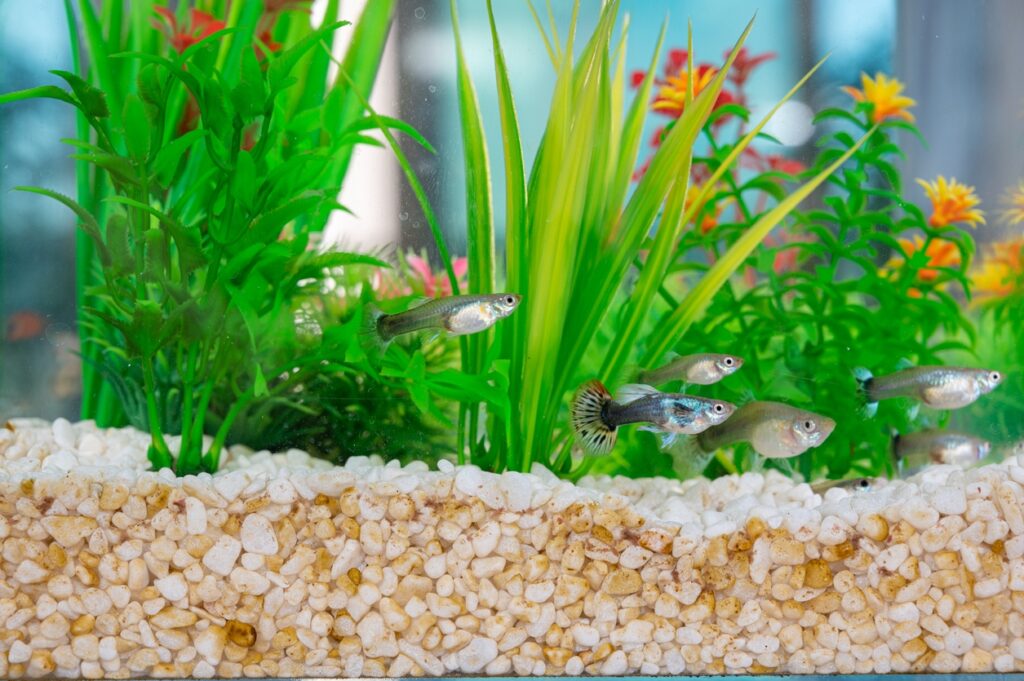
Top 10 Freshwater Aquarium Fish: A Guide to Species, Size, and Compatibility
| Species Name | Scientific Name | Max. Size (inches) | Temperament | Tank Size (gallons) | Water Temperature (°F) | pH Range | Diet | Difficulty Level | Compatibility |
|---|---|---|---|---|---|---|---|---|---|
| Neon Tetra | Paracheirodon innesi | 1.5 | Peaceful | 10 | 68-78 | 6.0-7.0 | Omnivore | Easy | Peaceful |
| Guppy | Poecilia reticulata | 2.5 | Peaceful | 10 | 72-82 | 7.0-8.5 | Omnivore | Easy | Peaceful |
| Angelfish | Pterophyllum scalare | 6.0 | Semi-aggressive | 30 | 75-82 | 6.8-7.8 | Omnivore | Moderate | Semi-aggressive |
| Betta | Betta splendens | 3.0 | Aggressive | 5 | 76-82 | 6.0-7.5 | Carnivore | Easy | Peaceful |
| Swordtail | Xiphophorus helleri | 4.0 | Peaceful | 20 | 72-82 | 7.0-8.4 | Omnivore | Easy | Peaceful |
| Cherry Barb | Puntius titteya | 2.0 | Peaceful | 10 | 72-82 | 6.0-8.0 | Omnivore | Easy | Peaceful |
| Corydoras Catfish | Corydoras spp. | 3.0 | Peaceful | 20 | 72-78 | 6.0-7.5 | Omnivore | Easy | Peaceful |
| Kuhli Loach | Pangio kuhlii | 3.0 | Peaceful | 20 | 75-86 | 6.0-7.5 | Carnivore | Moderate | Peaceful |
| Rosy Barb | Pethia conchonius | 6.0 | Semi-aggressive | 30 | 72-82 | 6.0-7.0 | Omnivore | Easy | Semi-aggressive |
| Zebra Danio | Danio rerio | 2.0 | Peaceful | 10 | 64-75 | 6.0-8.0 | Omnivore | Easy | Peaceful |
60 Best Freshwater Aquarium Fish Species
Here are a few of our favorite freshwater aquarium fish for beginners:
1. Cory Catfish
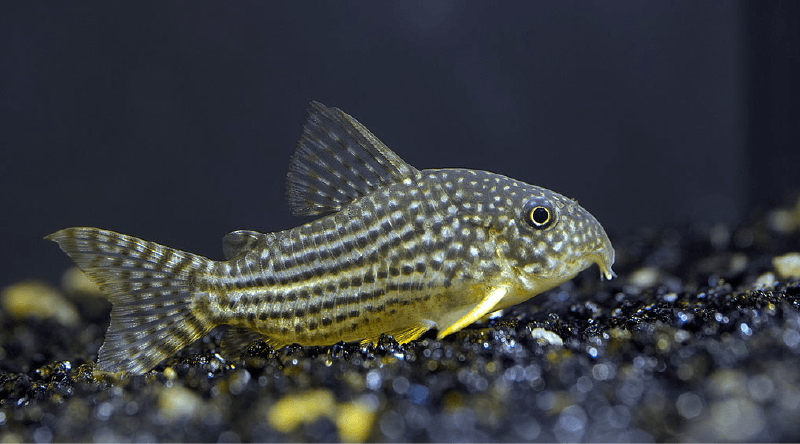
Cory Catfish are excellent freshwater aquarium fish for keepers of any skill level. They prefer soft, acidic water conditions but thrive in neutral, and even alkaline water. Unlike other bottom dwelling catfish, Corydoras are active during the day. Some, like the Pygmy Cory (Corydoras pygmaeus), swim in the middle region of the tank instead of along the bottom.
Since Cory Catfish are schooling fish, they need to be kept in groups of at least 4-5. They are not picky eaters and thrive on a mixture of flakes and micro pellets. Live bloodworms and tubifex worms are a great supplemental food that will encourage your Cories to spawn.
Cory catfish are docile fish. So keep them with with other peaceful species such as Tetras, Mollies, Loaches, Plecos, and Danios.
- Care Level: Easy
- Temperament: Peaceful
- Tank Size: 20 gallons for groups of 5
2. Guppies
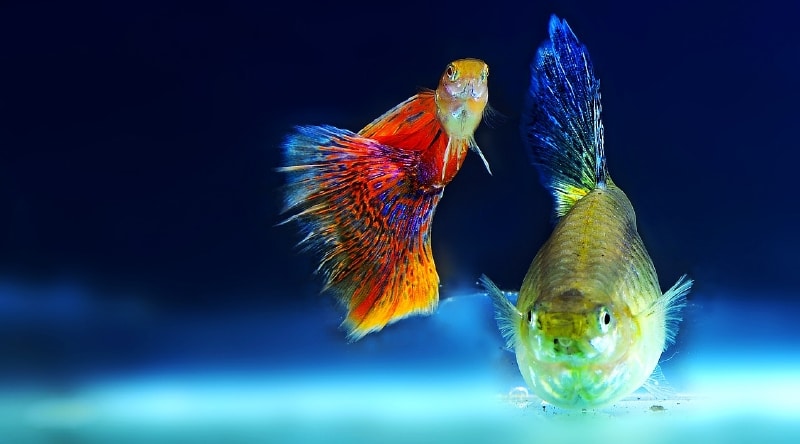
Fancy Guppies have been aquarium favorites for several decades. Reasons include their hardy nature, bright coloration, and ease-of-care. Even first time fish keepers will be able to breed them.
As nano fish, Guppies do well in smaller aquariums. A 10 gallon tank will be enough for several pairs and their babies. Guppies do reproduce fast, though. 5 will turn into 50 in no time. So try to have an idea on where to rehome guppy fry. The parents will eat many but not all of them.
In terms of care, Guppies are about as easy as they come. As long as your aquarium is set up correctly and you feed with a high quality flake food, raising a healthy school of guppies should be a piece of cake.
- Care Level: Easy
- Temperament: Peaceful
- Tank Size: 10 gallons
3. Mollies
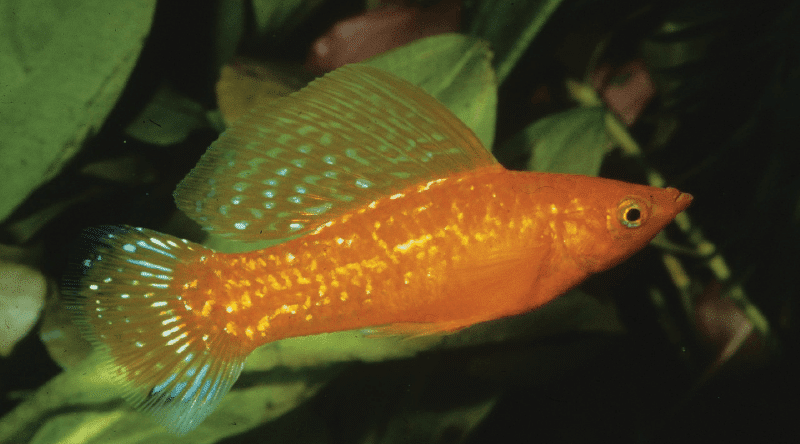
Molly fish are a little more challenging to keep than their close cousin the Guppy. But they are still well within the abilities of beginners to keep. Mollies also fill the tank with babies and are hardy fish.
But they also grow larger. 20 gallons is a better minimum tank size for sailfin mollies. While a few common mollies will be okay in a 10 gallon tank.
Mollies are omnivorous but need vegetable matter in their diet. They also need small amounts of aquarium salt in their water. Mollies can live even in brackish and marine aquariums. If they don’t get salt Molly fish become prone to diseases like aquarium fish ich.
- Care Level: Easy
- Temperament: Peaceful
- Tank Size: 10-20 gallons
4. Swordtails
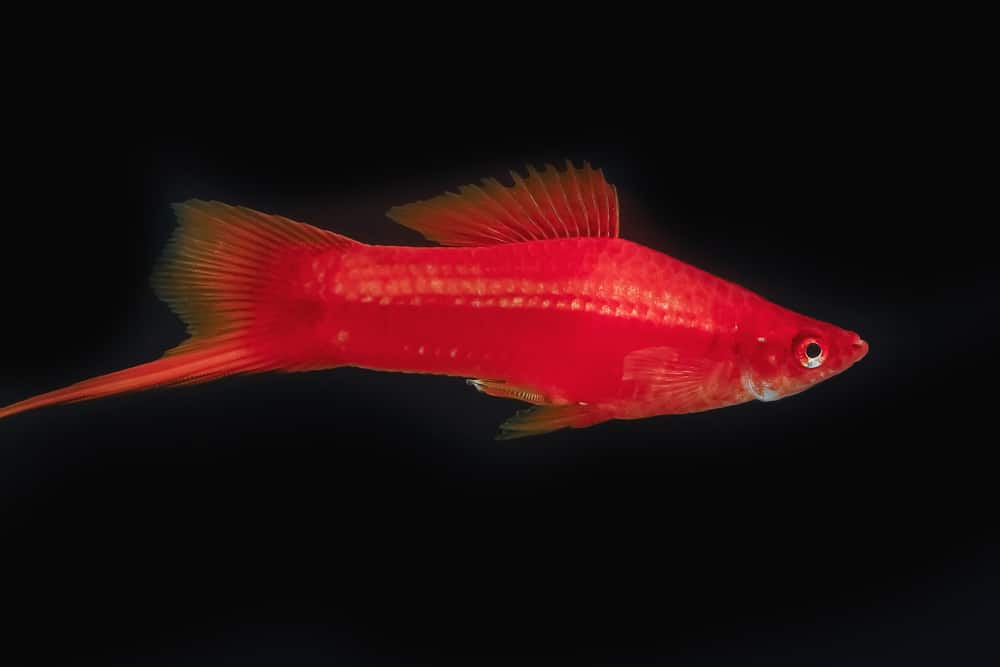
Swordtails are also livebearers, much like Guppies and Mollies. It’s easy to see where their name comes from. The males have tail swords but not the females. The “sword” is a display like a peacock’s tail feathers though, not a weapon.
Like all livebearers, Swordtails are easy to keep and thrive in a wide range of environments. If kept in groups, Swordtails will also reproduce all of the time. As a peaceful species, they should be kept with other community-friendly fish.
- Care Level: Easy
- Temperament: Peaceful
- Tank Size: 20 gallons
5. Kuhli Loach
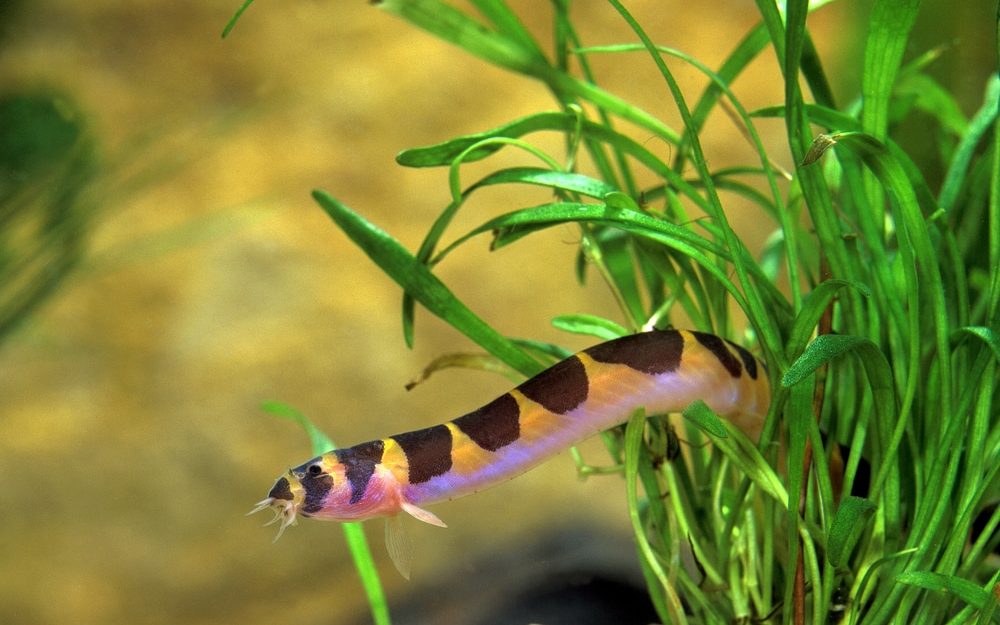
Kuhli loaches are one of the more unique freshwater aquarium fish here. They look like eels but they are not related at all.
Kuhli Loaches are most active at night. So don’t expect to see them often during the day. Kuhli loaches will come out more during the day if they are kept in groups of 3-4. The smell of food also entices them to start exploring.
Another reason that Kuhli Loaches make great beginner aquarium fish is because they stay small. At 3-5″ max length, a group will live a 20 gallon aquarium with comfort.
- Care Level: Easy
- Temperament: Peaceful
- Tank Size: 20 gallons
6. Neon Tetra
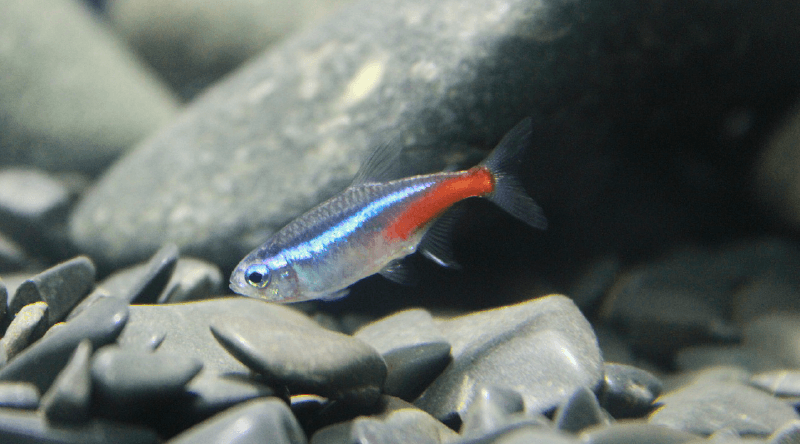
Neon Tetras are small fish known for their bright colors and interesting schooling habits.If you prefer a tank with fast, active fish then Neon tetras are a good choice.
Since Neons max out at around 1-1.5″ a good size schools can be kept even in small tanks. I like to stock 1 Neon Tetra per gallon of water.
Neon Tetras are not too difficult to keep. But soft, acidic conditions will improve their health and feeding response. Hard water makes them disease prone and shortens their life span.
Make sure your tank is well cycled. Tetras are sensitive to ammonia and other nitrogenous waste products. Neon tetras should be the last fish you add to a new community tank.
- Care Level: Moderate
- Temperament: Peaceful
- Tank Size: 10 gallons
7. Bristlenose Pleco
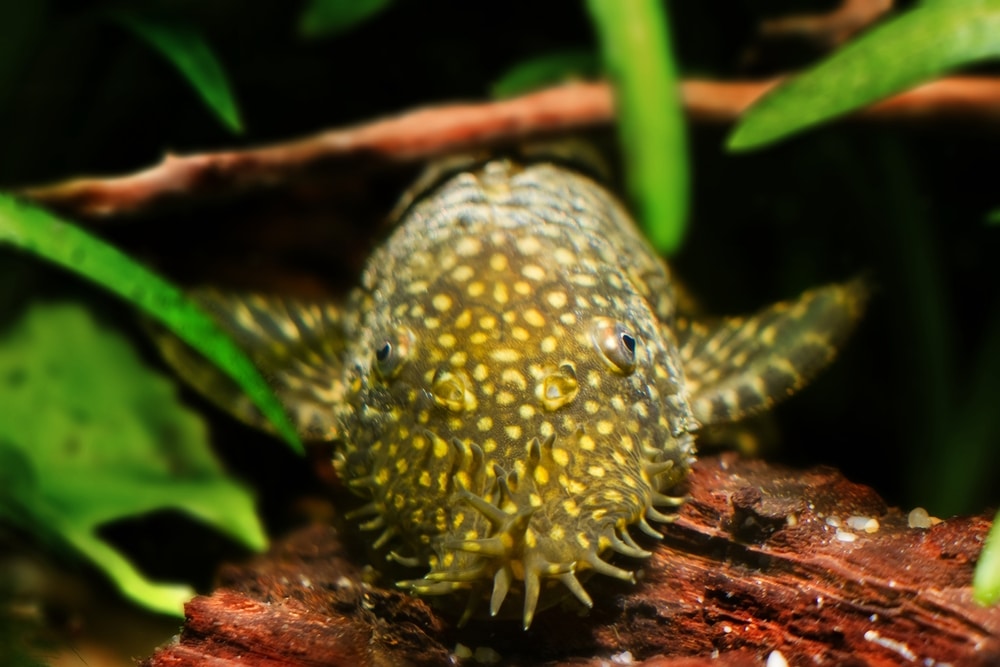
The Bristlenose Pleco is also referred to as the Bushy Nose Pleco or Armored Catfish. They are one of the most popular types of Plecostomus in the aquarium hobby.
Bristlenose plecos remain smaller than other suckermouth catfish. And they don’t become aggressive as adults, either. At right under 5″, they should be kept in tanks of at least 30 gallons.
Bristlenose Plecos are excellent algae eaters that help clean up aquariums. Aquarium owners should also offer supplemental feedings of algae wafers if it starts to run out, however.
8. Betta Fish
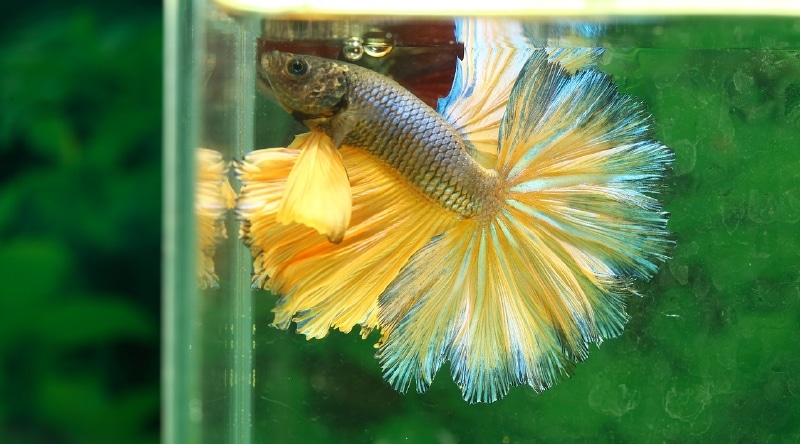
Even if you have never owned an aquarium before, chances are you’ve heard of Betta fish. These freshwater aquarium fish are famous for their bright coloration and aggressive disposition.
Bettas are also called Siamese fighting fish since they were bred in Thailand for centuries. People chose fish that were not just beautiful but also vicious. Male fish can’t stand each other and will fight to the death if kept together.
An oft-repeated myth is that Bettas do fine in small bowls. But anything under 5 gallons is much too small for one. These fish need well-filtered aquariums with heat and space to roam. My list of the best Betta tanks is a great resource for housing a Betta the correct way.
Bettas can live in a tank to themselves but there are several other species that will co-habitat with them. A few suitable Betta tank mates include Cory Catfish, Plecos, and Tetras.
- Care Level: Easy
- Temperament: Semi-Aggressive
- Tank Size: 5 gallons
9. Zebra Danio
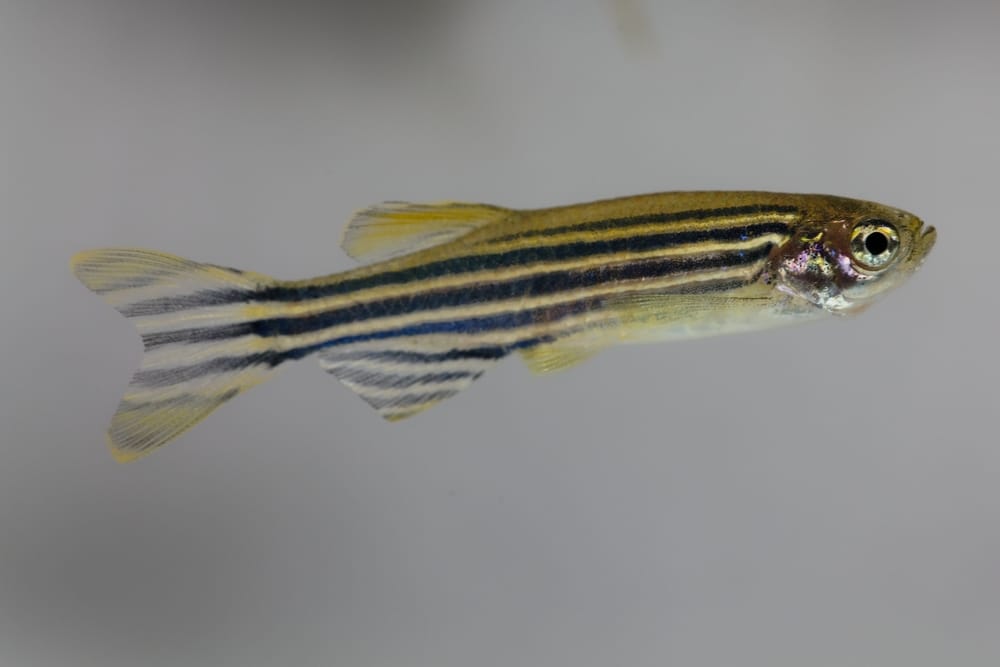
Zebra Danios are prized for their distinctive striped patterns, energetic swimming behavior, and ease of care. They do best in neutral water and will live in both tropical and unheated coldwater aquariums.
Zebra Danios are most energetic when kept in small schools. A group of 7-8 Danios will provide all the entertainment you need from a freshwater tank. Because they are active all of the time, a tank of at least 20 gallons is recommended.
- Care Level: Easy
- Temperament: Peaceful
- Tank Size: 20 gallons
10. Dwarf Gourami
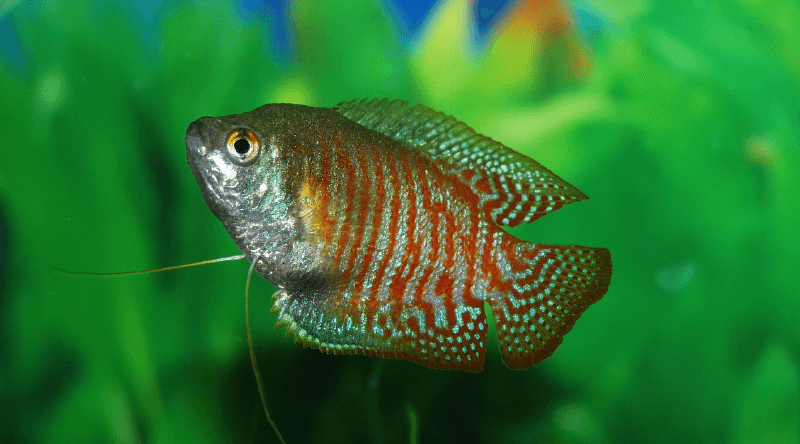
No list of the top freshwater aquarium fish should leave out the Dwarf Gourami. There are several species of gourami fish, all of which are deep bodied and colorful. Yet only a few remain small enough for 20 gallon tanks.
Dwarf gouramis do best with other fish that love the same Southeast Asian water conditions. High temperatures (75-80℉) and soft, acidic chemistry are what they need. Loaches, tetras, barbs, and cory catfish also prefer these conditions.
Feed Dwarf Gouramis micro pellets and flakes. With live and frozen food as an occasional treat.
- Care Level: Easy
- Temperament: Semi-Aggressive
- Tank Size: 20 gallons
11. Goldfish
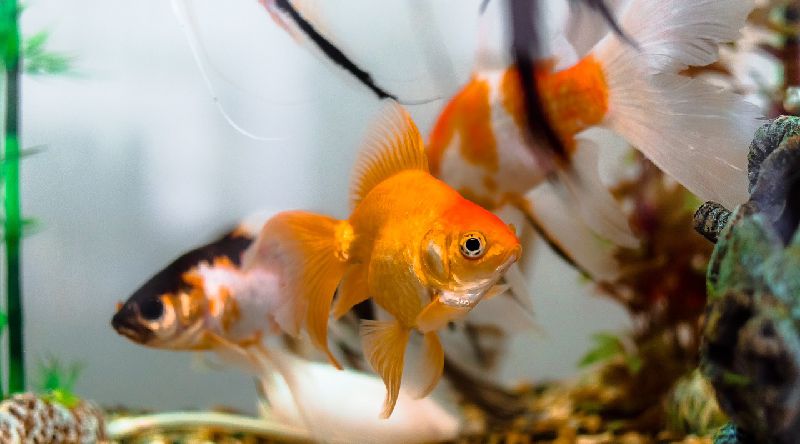
Goldfish might be the most popular freshwater aquarium fish of all time. Goldfish come in hundreds of different varieties and colors. And they are all easy to keep and live for decades.
Goldfish should not be kept in bowls, either. A goldfish tank needs to be at least 20 to 30 gallons in volume. With 10 gallons of extra space per additional goldfish.
Goldfish are otherwise Goldfish are easy to keep and do well in a wide range of conditions. Aquarists of all skill levels will be able to keep them healthy. Goldfish do need a cooler environment than most tropical aquarium fish (68-75°F).
So they tend to do best in goldfish-only tanks. Or with other coldwater fish like dojo loaches and koi carp. Goldfish also do well on a simple flake food diet. So no special kinds of food are required.
- Care Level: Easy
- Temperament: Peaceful
- Tank Size: 20-30 gallons
12. Convict Cichlid
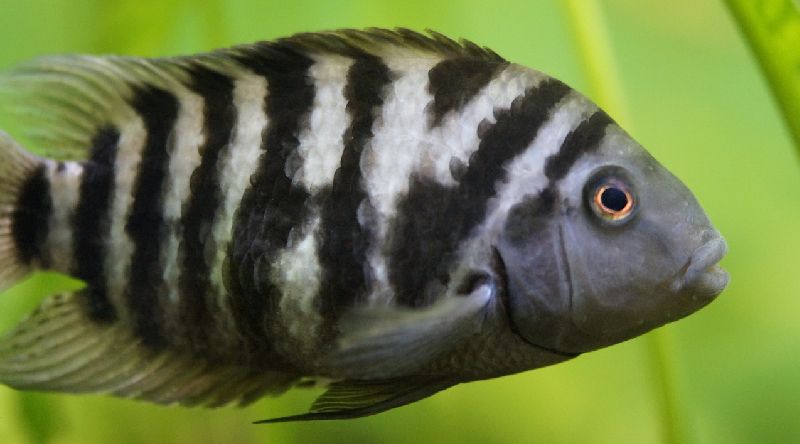
Convict Cichlids are good beginner cichlids because they stay small and breed with ease. At 3 to 4 inches a 20 gallon tank will be spacious enough for a pair. They will live alongside other fish but tend to be territorial. So choose fast-moving species like danios and tetras.
A male and female pair are guaranteed to spawn for you. You will need to move the other fish unless the tank is large (40+ gallons), however. Breeding Convict Cichlids are defensive of their eggs and fry. They will kill their tank mates in smaller aquariums.
- Care Level: Easy
- Temperament: Aggressive
- Tank Size: 20 gallons
13. African Cichlids
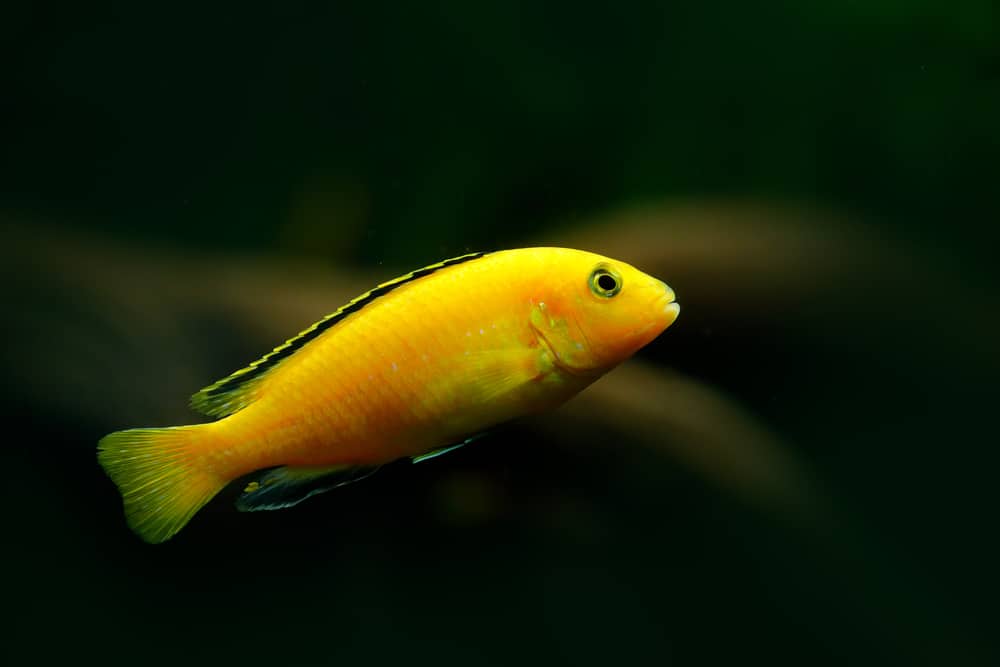
The term “African Cichlid” is a blanket term that includes tons of different Cichlid species (over 1,200). Some of the most popular include the Yellow Lab Cichlid, Peacock Cichlid, and Zebra Cichlid.
African Cichlids are colorful, hardy, and easy to feed. As with most cichlids, though, they are aggressive. The best tank mates are other African Cichlids since they share the same need for hard, mineral-rich water. So long as their temperaments are similar, any fights will be brief and never to the death.
Most African Cichlids are mouth-brooders, meaning they hold offspring in their mouths for 3-4 weeks until they can fend for themselves.
- Care Level: Easy
- Temperament: Semi-Aggressive to Aggressive
- Tank Size: 20-40 gallons
14. Red Cherry Shrimp
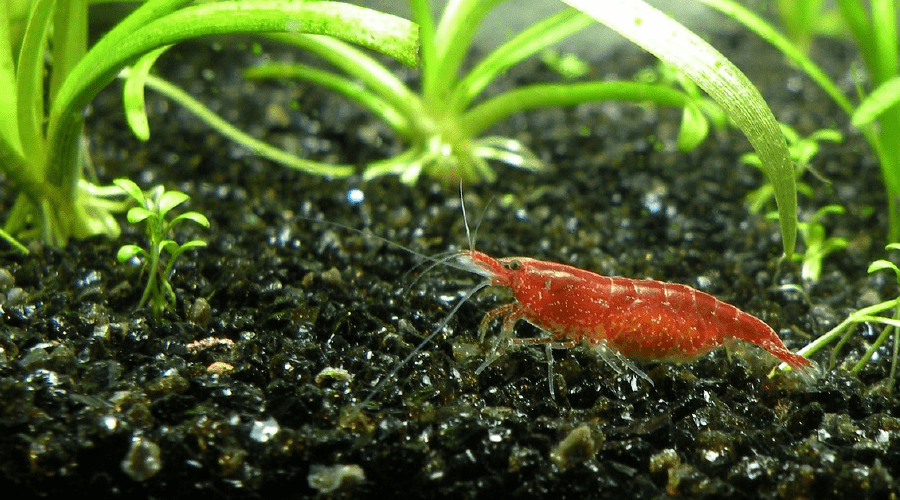
Invertebrates are not the easiest of aquarium pets Red Cherry Shrimp are an exception. They are small, colorful, and even swim in the middle of the tank.
Cherry shrimp are algae and biofilm feeders. They also can be fed a preformulated shrimp diet and boiled vegetables. Red Cherry Shrimp are easy to breed and will soon fill your tank with tiny red babies.
Since shrimp are on the menu for most fish, keep Red Cherry Shrimp with peaceful freshwater aquarium fish of the same size.
- Care Level: Easy
- Temperament: Peaceful
- Tank Size: 5 gallons
15. Cherry Barb
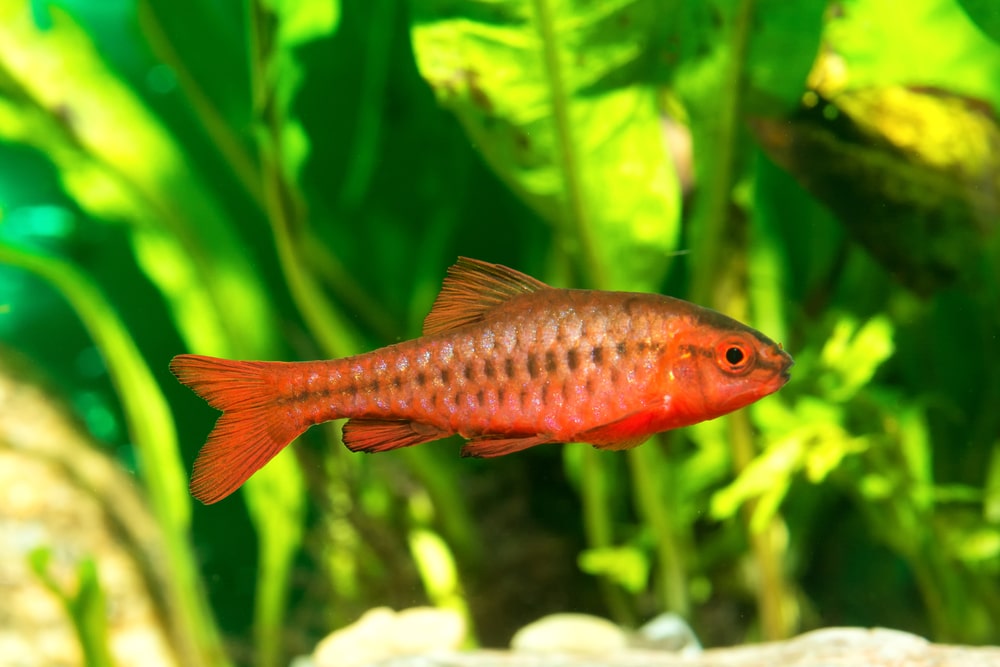
Cherry barbs are hard to match when it comes to colorful aquarium fish. These bright red barbs are more like tetras in terms of their care. They aren’t fin nippers and keep to themselves in loose shoals. But you can also keep a Cherry Barb alone. It won’t show its brightest colors, however. Males color up to impress females and rivals.
Cherry barbs are omnivores and eat both plant and animal matter. They may nibble on soft plant leaves but prefer hair algae for greens. Flakes, pellets, and frozen food should form the high-protein portion of their diet.
- Care Level: Easy
- Temperament: Peaceful
- Tank Size: 20 gallons
16. Tiger Barb
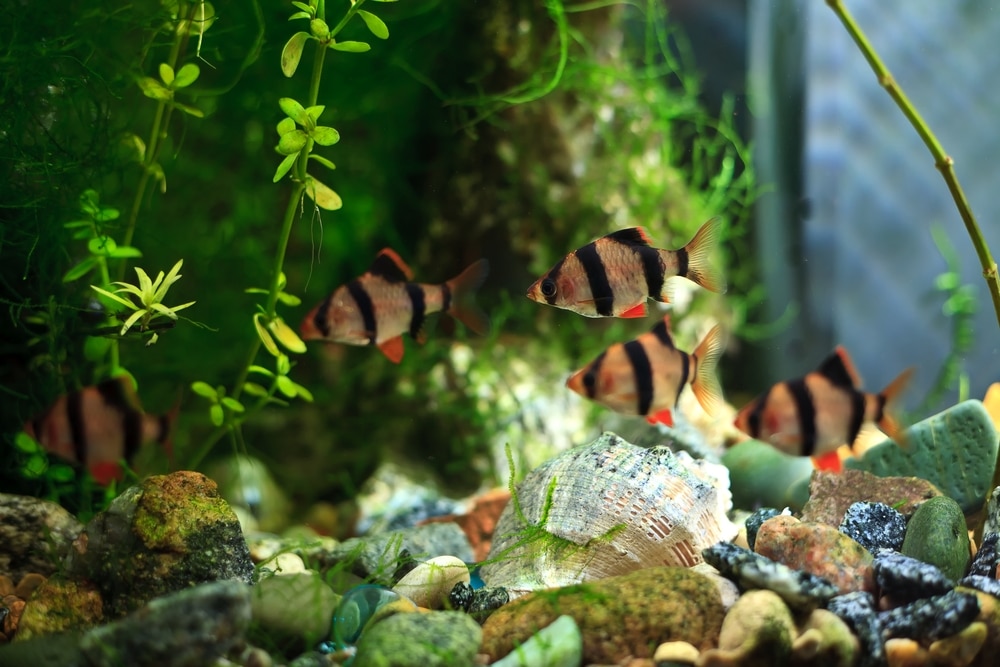
Tiger barbs are a medium sized barb species, reaching 2 to 3 inches in length. The base form is a beautiful cream and black color, with red tips to the nose and fins of males.
Tiger barbs are known to be fin nippers. They should not be kept with betta fish, angelfish, and other long finned tank mates. But they do fine with any fish similar in size to them.
As an omnivorous species, Tiger Barbs should be fed a mix of flake food and meaty food (frozen brine shrimp or bloodworms) for optimal health. They also feel most “at home” in planted aquariums.
- Care Level: Easy
- Temperament: Peaceful (Fin Nipper)
- Tank Size: 20-30 gallons
17. Oscar Cichlids
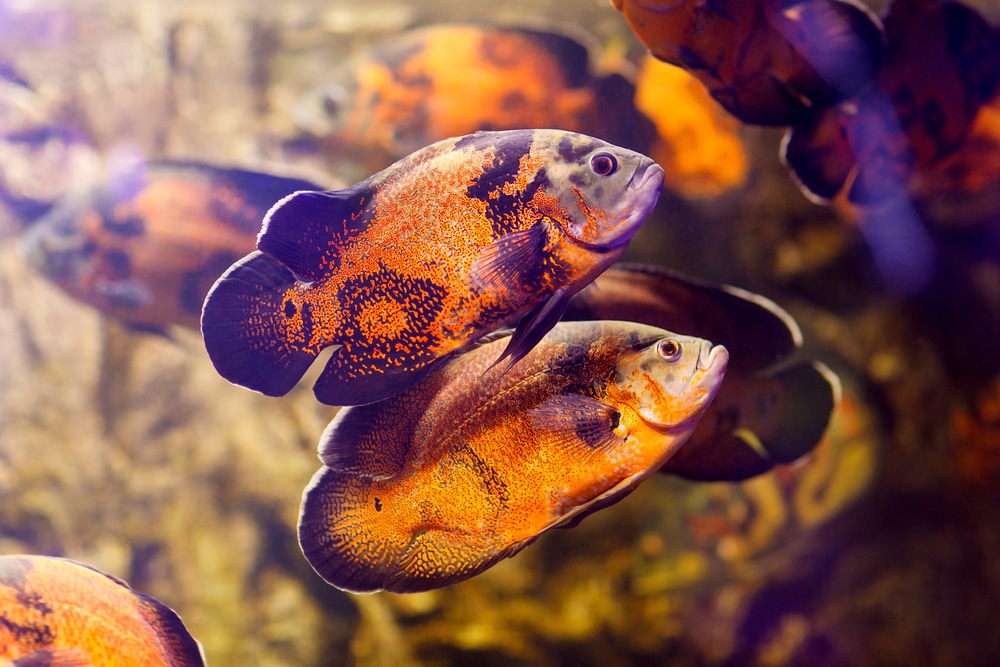
- Scientific Name: Astronotus ocellatus
- Common Names: Oscar, Oscar fish, Marble Cichlid
- Care Difficulty: Moderate
- Temperament: Semi-Aggressive
- Minimum Tank Size: 75 gallons
Oscar fish are a big commitment given how large they grow, not to mention their similar lifespans to dogs. They also have distinct personalities, which is unusual for a fish. An adult oscar will eat out of your fingers and may even let you pet it.
Oscars can learn to recognize their owners and normally respond very positively to them, with some going as far as allowing their owners to pet them.
f you have enough space, food, and time for water changes then Oscars are not difficult to keep. Larger aquariums are often easier than small ones. Water chemistry does not shift so fast in a big tank. Stable conditions are better for long-term fish health.
Oscars are hardy as well and resistant to high ammonia levels. They also come in several color variants, including Red, Tiger, and Albino Oscar morphs.
As long as you commit to 10+ years of life with a 12 inch fish, Oscars are great for beginners. They are much more interactive than other aquarium freshwater fish.
18. Platies
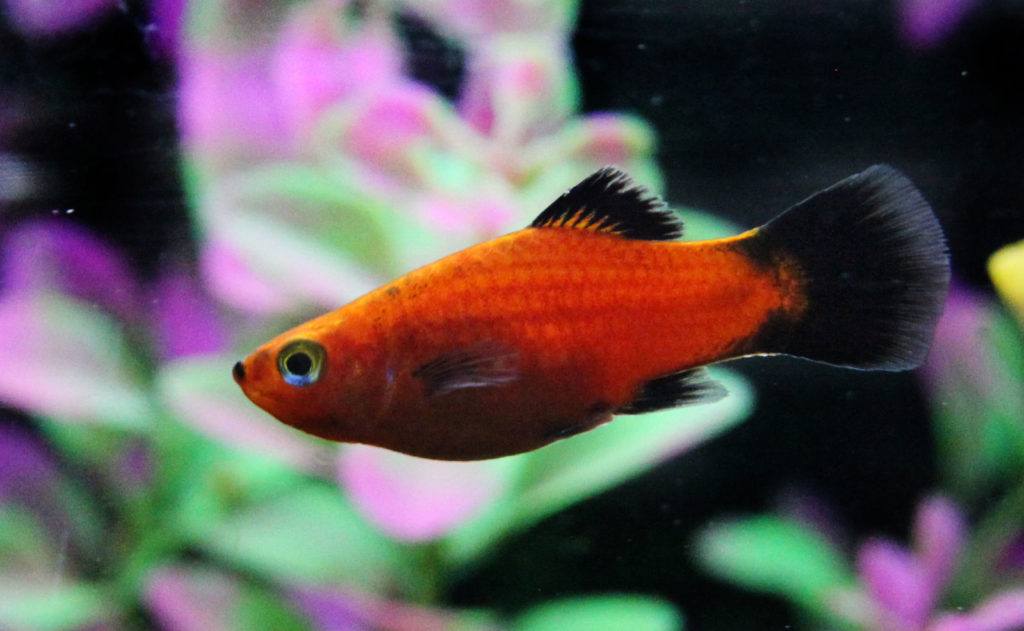
- Scientific Name: Xiphophorus maculatus
- Common Names: Platy, Moonfish
- Care Difficulty: Easy
- Temperament: Peaceful
- Minimum Tank Size: 10 gallons
One of the hardiest fish out there, the platy comes in a massive variety of styles and colors. Platies are a hard water fish, so they do best in mineral-rich conditions. Tap water in most countries is hard and alkaline. So little treatment is needed beyond dechlorinating it.
They are also a live bearing fish, meaning they give birth to well-developed live young, instead of eggs like most other fish. The young do not need any special care, aside from their food being smaller than the adults’ food. They are born ready to eat and survive but you may want to provide extra hiding areas. The adults will try eating them before they have a chance to get bigger.
One way or another, if you have a female, she will give birth, and some of the young will survive. Be sure you have enough space to house them or have other homes lined up for them.
Platies are peaceful fish and will coexist with a wide range of tank mates. Feed them a mixture of vegetable and animal matter since they are omnivores.
19. Pearl Gourami
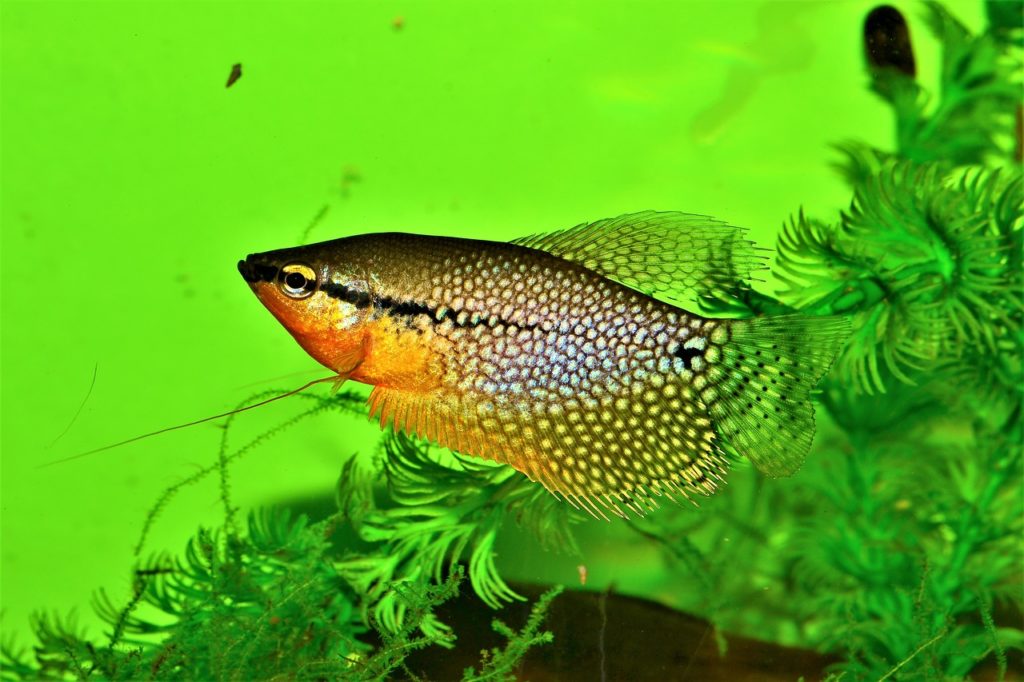
- Scientific Name: Trichopodus leerii
- Common Names: Lace Gourami, Mosaic Gourami
- Care Difficulty: Easy
- Temperament: Peaceful
- Minimum Tank Size: 30 gallons
The Pearl Gourami is named for the beautiful, white, circular patterning across its body. They are one of the most exotic looking fish on this list and are often used as centerpiece fish in aquariums.
Pearl gourami do great in community aquariums, as long as there are no other labyrinth fish. Gouramis, which are labyrinth fish, will coexist with other fish. But they are aggressive towards each other.
A labyrinth fish has both gills and a labyrinth organ, which is essentially a primitive lung. Ensure your gourami can access the top of the water to breathe air whenever they want, or else they may begin to suffocate.
Pearl gourami are easy to feed, not picky with water hardness (though they prefer soft water), and do not require more maintenance than other fish.
20. Discus
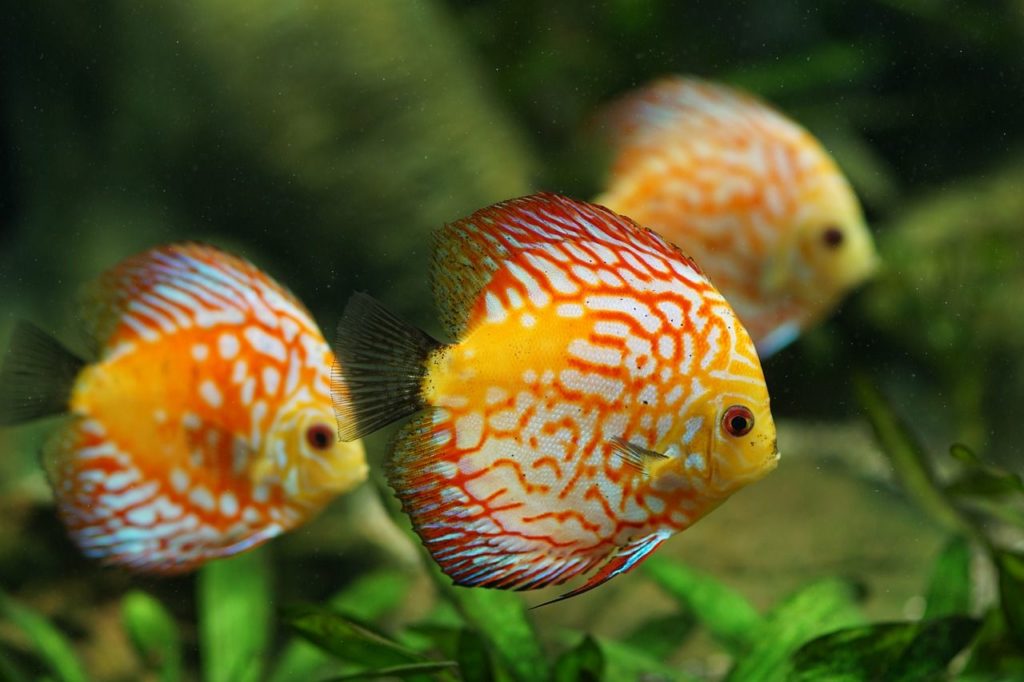
- Scientific Name: Symphysodon discus, S. tarzoo, S. aequifasciatus, S. haraldi
- Common Names: Discus, Pompadour Fish, King of the Aquarium
- Care Difficulty: Intermediate
- Temperament: Peaceful
- Minimum Tank Size: 60 gallons
The Discus fish is considered a “holy grail” or “the kind of cichlids” in freshwater aquarium fish keeping. They are also regarded as one of the most difficult to care for fish. Yet they can be kept by beginner fish keepers. I recommend them so long as you are well informed and able to provide excellent water quality.
Discus are more demanding than your average fish, so it helps to have experience with at least one other fish before moving to Discus. When you first start keeping Discus, you will want to start with some of the lower-grade fish. These will still cost $20-40 USD each.
Their main issue is ammonia, nitrite, and even nitrates. While most fish tolerate nitrate at 20-40ppm fine, it is best to keep the nitrates in a Discus tank between 0-10ppm. These cichlids need more water changes than other fish. Their meat heavy diet does not help since it produces a lot of nitrogenous waste.
You have to provide a large tank and appropriate food, which often includes beef heart and homemade fish food. Discus also have to be kept in schools of at least 6 individuals.
21. Killifish
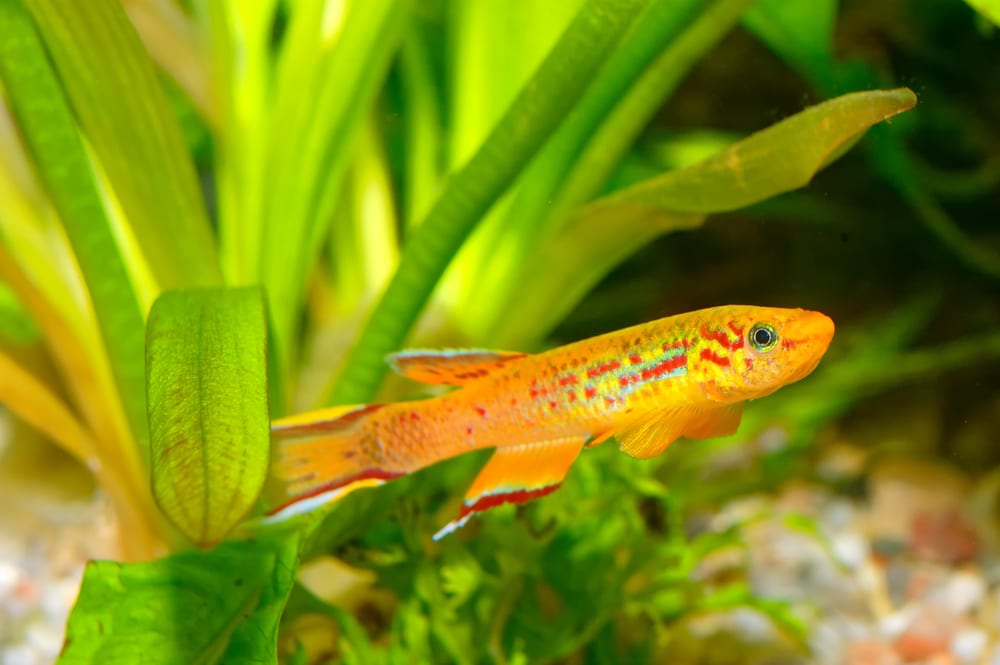
- Scientific Name: Several families of fish
- Common Names: Killifish, killie, topminnow
- Care Difficulty: Beginner, Intermediate, Advanced, depending on the species
- Temperament: Peaceful
- Minimum Tank Size: 10-20 gallons
While there are hundreds of species of killifish, here we will go over some of the common aspects of care. Most species you can find for sale will fall under this category and general care, as the sensitive ones are harder to find and only sold online.
Killifish are hardy fish that survive conditions fatal to other fish. And while they are prone to jumping, they do not have any other downsides. Most of the males have magnificent coloration, such as Fundulopanchax. gardneri.
Unlike the other fish on this list, killifish do best in a species only tank, or a tank that only houses one species of fish. They are skittish and tricky to feed. A community tank may cause a lot of stress for them.
Simply because there are so many species, and because each one has slightly different requirements, they do require more in-depth research than other beginner species. So start with my guide to killifish care, for more specifics.
22. Rainbowfish
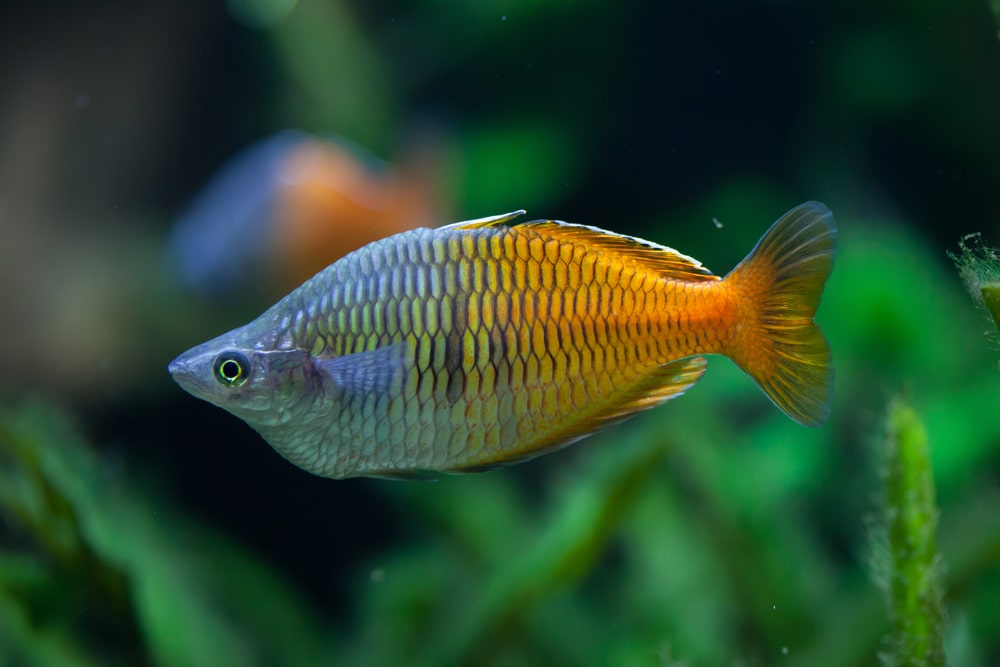
- Scientific Name: Melanotaeniidae
- Common Names: Rainbowfish
- Care Difficulty: Beginner to Intermediate
- Temperament: Peaceful
- Minimum Tank Size: 55 gallons
Rainbowfish are large and colorful schooling fish. They are best suited for spacious community tanks that are 55 gallons in volume or larger.
They are active swimmers, which will make other fish feel safer. Yet they are also hardy and easy to take care of. Rainbowfish are neither picky eaters nor aggressive towards tank mates.
Rainnbowfish do best in planted tanks with thick growth as they like to weave in and out of the foliage. Green plants also provide the perfect contrast to their bright colors. Which will really make these freshwater aquarium fish stand out.
23. Angelfish
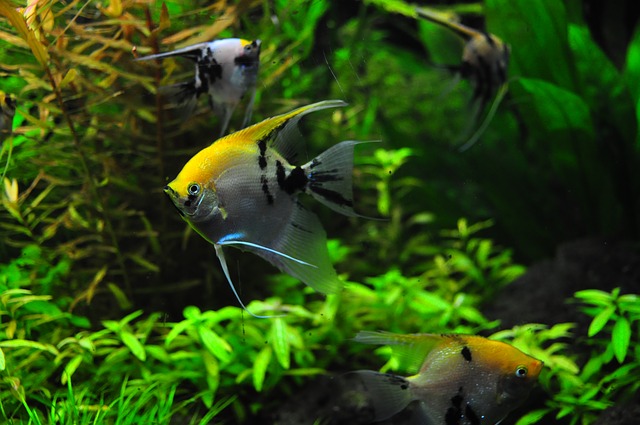
- Scientific Name: Pterophyllum scalare
- Common Names: Angelfish, Freshwater Angelfish
- Care Difficulty: Beginner
- Temperament: Semi-Aggressive
- Minimum Tank Size: 29 gallons
There are many varieties of freshwater angelfish. These fish have been captive bred for a long time. So you get to choose from several different colors, fin shapes, and even scale types. They are as diverse as betta fish in appearance.
They are also similar to betta fish in temperament. Angel fish are cichlids, and most cichlids have distinct personalities and temperaments. While one angelfish may be passive towards its tank mates, another may become aggressive.
You do not need to be experienced to deal with an angelfish’s aggression. It is not too severe, and it’s easy to managed. Keeping several angelfish together also helps. They will focus their behavior on each other instead of their tank mates.
Cichlids are otherwise great starter fish. They are hardy, strong, personable, and are a great pet to own. They have distinct personalities and it is hard not to get attached to them.
24. Firemouth Cichlids
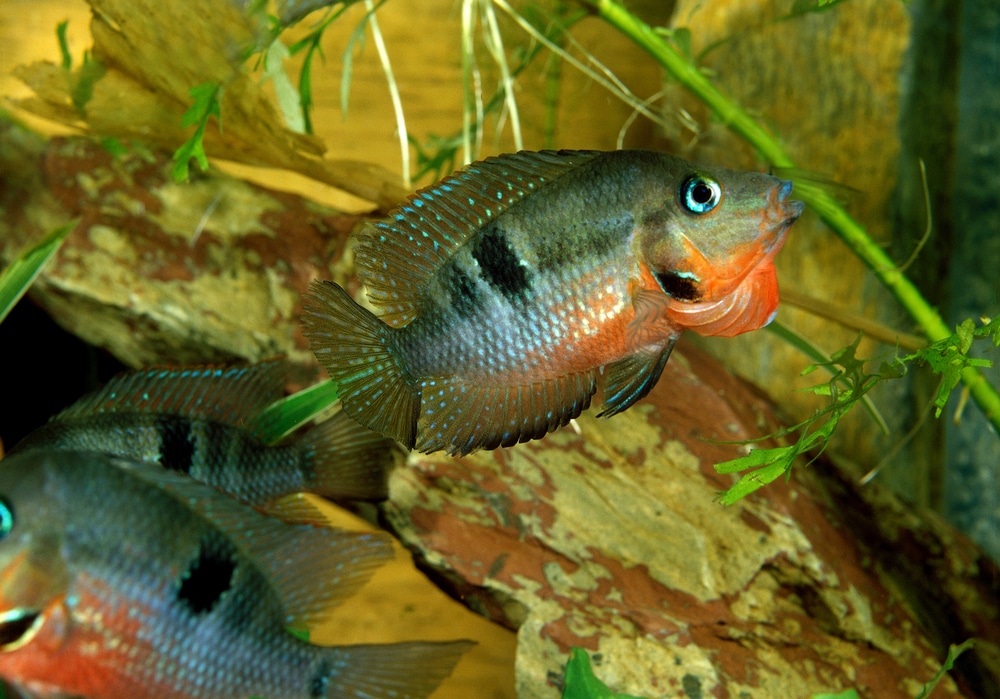
- Scientific Name: Thorichthys meeki
- Common Names: Firemouth, Fire Cichlid
- Care Difficulty: Beginner to Intermediate
- Temperament: Semi-Aggressive
- Minimum Tank Size: 29 gallons
Firemouth cichlids are flashy Central American cichlids. Their iridescent scales and fiery throat are eye-catching. Especially when they challenge each other with gill and fin flaring.
They also thrive in a wide range of water parameters, so nothing needs to be done to provide them with special water or alter the water you already have.
Like other cichlids, they can be aggressive, especially when breeding. But as long as you chose tank mates of a similar size, the aggression will not last long.
Provide plenty of decorations such as rocks and driftwood, as these double as sight breaks and potential territories. If your cichlid can establish a territory around one or two decorations that they feel safe in, the tank will be peaceful.
25. Pictus Catfish
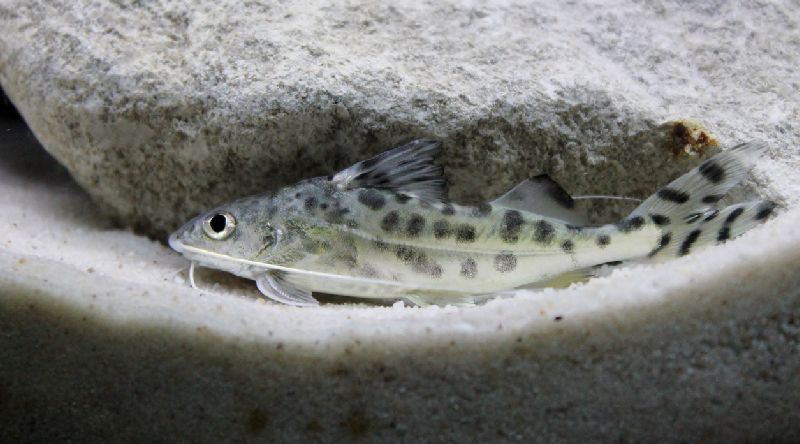
- Scientific Name: Pimelodus pictus
- Common Names: Pictus catfish, Pictus cat
- Care Difficulty: Beginner
- Temperament: Peaceful
- Minimum Tank Size: 55 gallons
Pictus Catfish have light gray bodies with bold black spots, and massive barbells, or whiskers. They will shoal if you keep them together, but you need a much larger tank. They are peaceful inhabitants of community aquariums, as long as there are enough decorations for them to hide in and among.
These catfish are active and do not stay at the bottom of the aquarium. Expect to see them swimming around in the mid-section of the tank.
While they are peaceful, they will eat smaller tank mates when hungry. So it is best to house them with larger fish.
26. Clown Loach
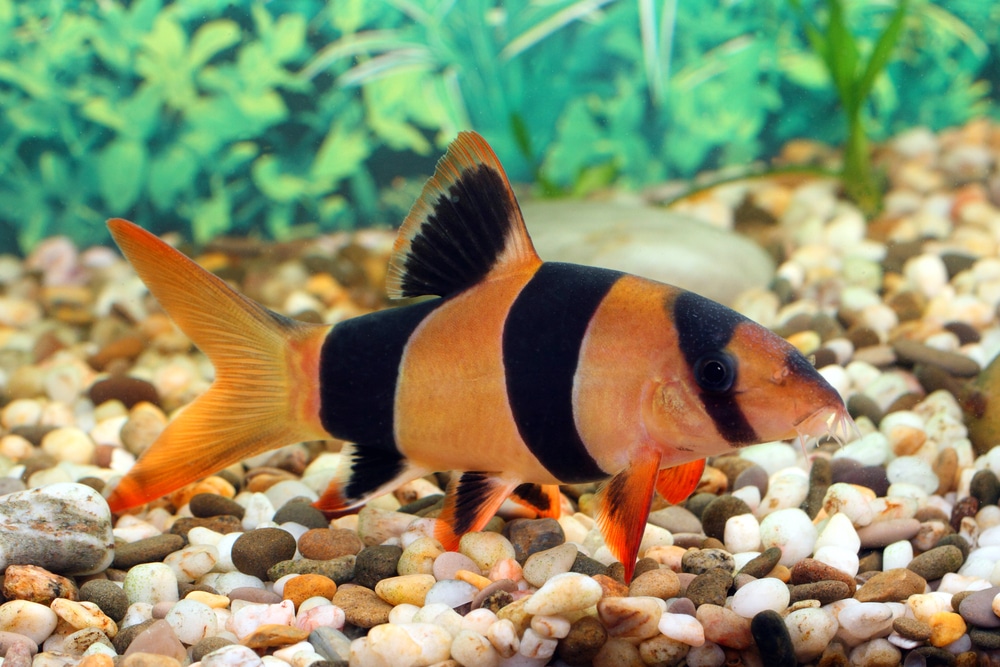
- Scientific Name: Chromobotia macracanthus
- Common Names: Clown loach, tiger botia, tiger loach
- Care Difficulty: Beginner to Intermediate
- Temperament: Peaceful
- Minimum Tank Size: 125 gallons
Clown loaches have large, bold, vertical black and yellow stripes, which make them stand out in any aquarium. They are boisterous and have to be kept in groups, so there is no way for them to blend into the background.
Many people get them in order to deal with snail infestations. But you need to be sure that you will be able to house a group of these large fish. They simply will not survive in small tanks. The bigger the tank you put them in, the happier and more active they will become.
Clown loaches do require quite a few hiding areas in order to be safe and stress free, thus reducing the chances of them getting sick. Otherwise they are prone to getting ich. And are hard to cure once they have it.
They are active during the day, unlike most loaches, so feeding them in a community setting will not be an issue. As long as you can manage their size, you will not have any trouble caring for these freshwater aquarium fish.
27. Harlequin Rasboras
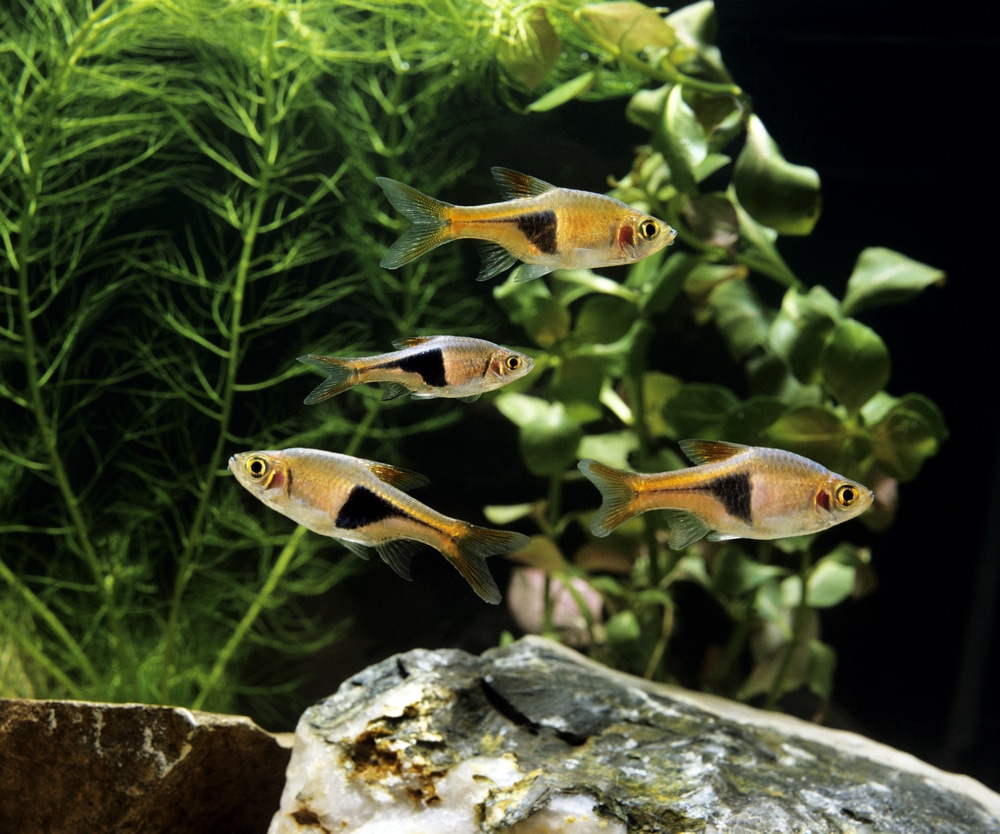
- Scientific Name: Trigonostigma heteromorpha
- Common Names: Harlequin rasbora, porkchop rasbora
- Care Difficulty: Beginner
- Temperament: Peaceful
- Minimum Tank Size: 20 gallons
Harlequin rasboras are a small species of schooling fish. They fit well into community aquariums and are adaptable when it comes to water conditions.
Harlequin rasboras are also beautiful. Their sides have red scales with a large, pork chop like black marking and shimmering iridescence.
Few fish keepers ever have trouble with this fish. Harlequin rasboras are not skittish and will not present any behavioral issues as long as their school is large enough.
28. Marble Hatchetfish
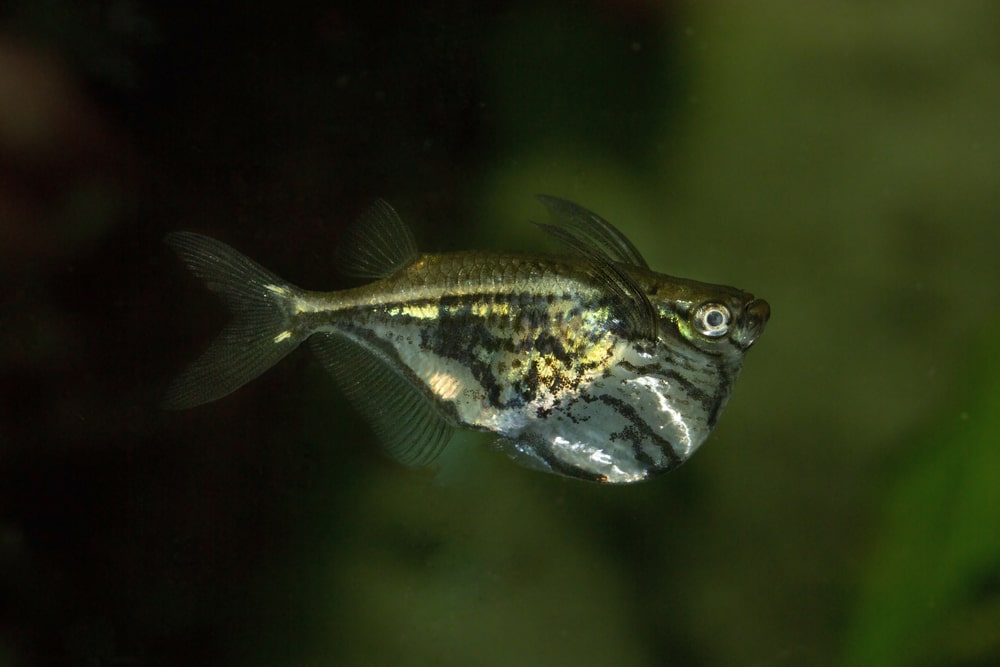
- Scientific Name: Carnegiella strigata
- Common Names: Marbled Hatchetfish
- Care Difficulty: Beginner
- Temperament: Peaceful
- Minimum Tank Size: 10 gallons
Marbled Hatchetfish have a gorgeous opalescent white and black marbled pattern, and the unusual body shape of a hatchet. They spend their time swimming just under the surface of the water, darting around in small groups.
They spend their time swimming just under the surface of the water, darting around in groups.
When housed with other small fish, they make wonderful community inhabitants, and their activity often encourages other fish to come out of hiding.
As long as you keep nitrates low, and the water isn’t very hard, you will have no issues with this fish. However, keep in mind that they are prone to jumping. So be sure to cover your tank.
29. Upside-Down Catfish
- Scientific Name: Synodontis nigriventris
- Common Names: Upside-down catfish, Blotched catfish
- Care Difficulty: Beginner
- Temperament: Peaceful
- Minimum Tank Size: 10 gallons
An upside-down fish is normally a bad sign. But the upside-down catfish spends all of its time in this position. They rest upside down on decorations and even when eating.
They have large eyes and barbels, and uniquely shaped fins. Upside down catfish present an earth toned pattern, with various shades of tan and brown patches, similar to a lizard. They do best in small schools and are peaceful community tank fish.
30. Celestial Pearl Danios
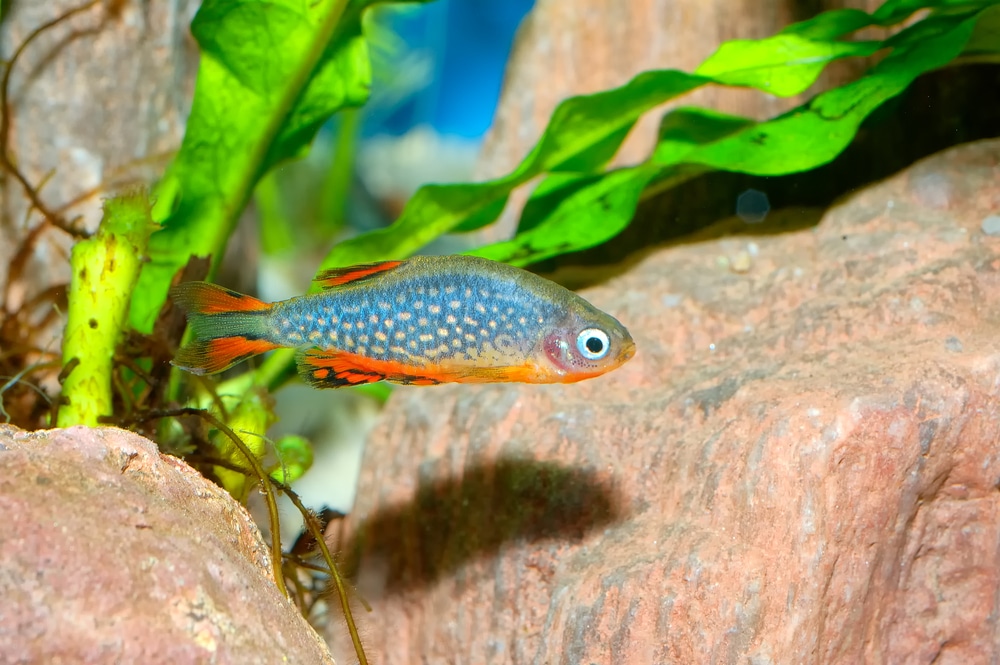
- Scientific Name: Danio margaritatus
- Common Names: Celestial pearl danio, cpd, galaxy rasbora
- Care Difficulty: Easy
- Temperament: Peaceful
- Minimum Tank Size: 10 gallons
Celestial pearl danios, also known as galaxy rasboras, are a very small schooling fish. If they are housed with tankmates of a similar size and temperament, they are excellent community fish.
They prefer planted tanks, as they are shy fish. Pants provide good natural hiding areas and help their coloration stand out.
CPD’s have blue-gray bodies with white spots and bold, contrasting orange and red fins. Just like other schooling fish, they need schools of at least 6 in order to feel comfortable.
Feeding and breeding is not difficult for these little fish. And they are not demanding in their water quality needs.
31. White Cloud Minnows
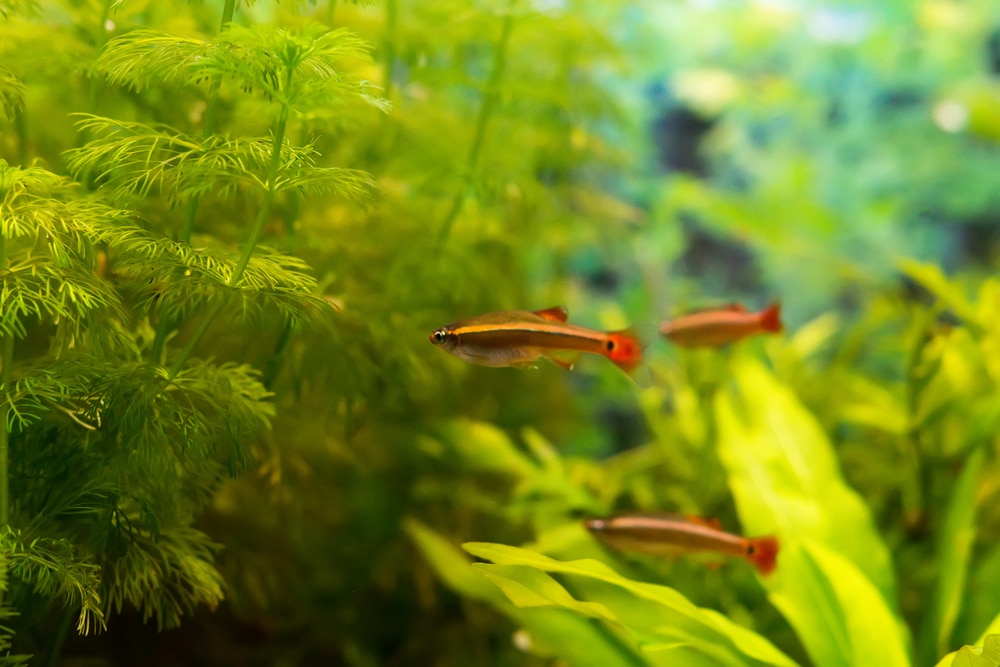
- Scientific Name: Tanichthys albonubes
- Common Names: White cloud mountain minnow, White cloud minnow, WCMM
- Care Difficulty: Beginner
- Temperament: Peaceful
- Minimum Tank Size: 10 gallons
White cloud mountain minnows (WCMM) are sometimes called Poor Man’s Neon Tetras. hey were introduced to the hobby a short time ago. Yet they have become popular in just a few years.
They are active yet peaceful freshwater aquarium fish. Their colors are subtle, with reflective white stripes and colorful red fins.
White cloud mountain minnows may be the hardiest fish on this list. They will thrive and even breed in most kinds of water chemistry.
They do need to be kept in schools of at least six fish. But they will coexist with any fish that won’t eat them. Mountain minnows also do well at temperatures ranging from 45 to 75℉.
32. Bichir
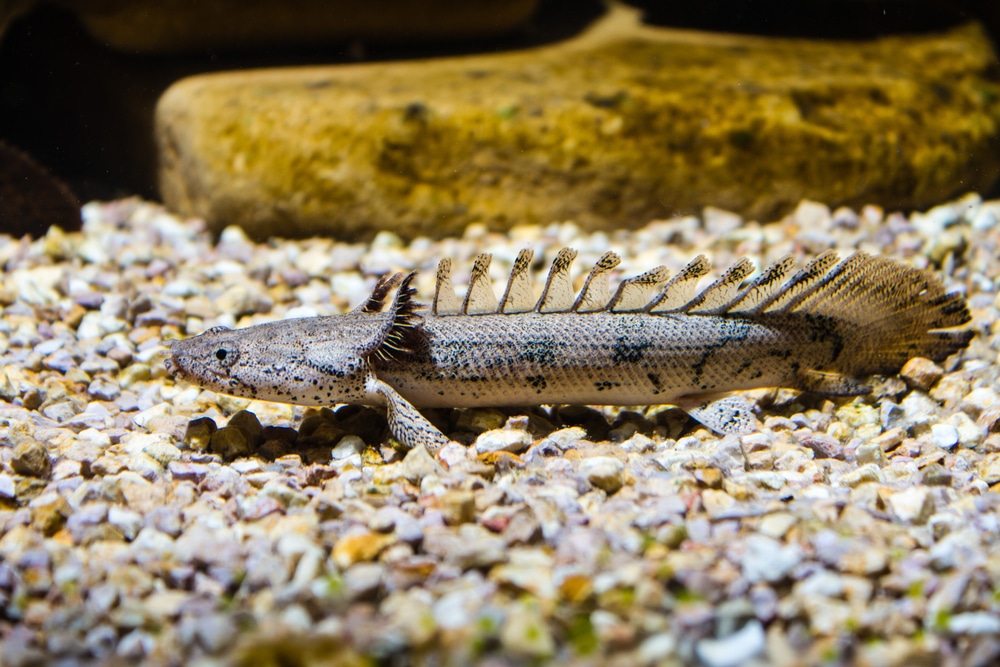
- Scientific Name: Polypteridae
- Common Names: Bichir, Dragonfish
- Care Difficulty: Intermediate
- Temperament: Peaceful
- Minimum Tank Size: 50-125 gallons
Bichirs aren’t aggressive, but they will attempt to eat any smaller fish in the tank. Most fish prefer community tanks, as the activity of other species make them feel safer.
But bichirs have no preference toward either a community tank or a species only tank. As solo predators they spend most of their lives alone.
Bichirs have voracious appetites, so the issue is not getting them to eat. Rather, their food will be expensive since they need a lot of it. They require frozen food, such as shrimp, mussels, clams, worms, and fish to be a primary part of their diet. Costs add up fast compared to pellets and flake food..
Despite this, owners rarely find the cost an issue because bichirs are so unique and fun to keep. There are no other fish like them except other prehistoric pets like lungfish.
33. Gold Barb
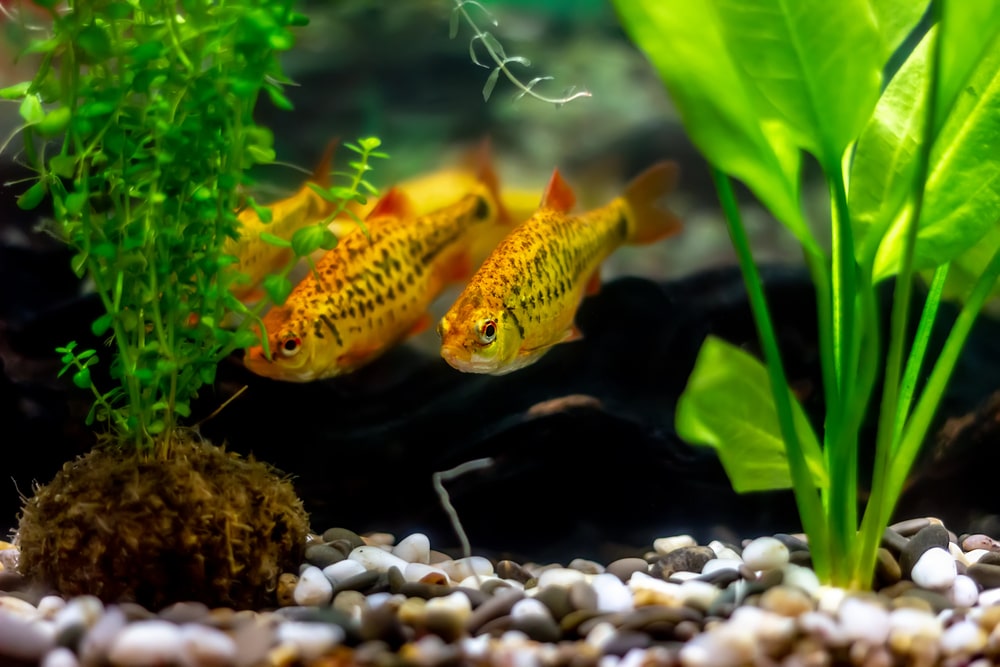
- Scientific Name: Puntius semifasciolatus
- Common Names: Gold barb, Chinese Barb
- Care Difficulty: Beginner
- Temperament: Peaceful
- Minimum Tank Size: 20 gallons
The gold barb is a large and flashy schooling fish, presenting a gold body with black speckling and bright red fins. Gold barbs come from China and, like goldfish, were bred from a wild ancestor with green scales.
Gold barbs will sometimes nip the fins of long-finned tank mates. But keeping them in a school will help control this behavior.
While they are not often centerpiece fish, they are great for enhancing other colors in the tank and helping with the overall aesthetic. Gold barbs are good beginner fish due to their hardiness, brilliant colors, and moderate size.
34. Rosy Barb
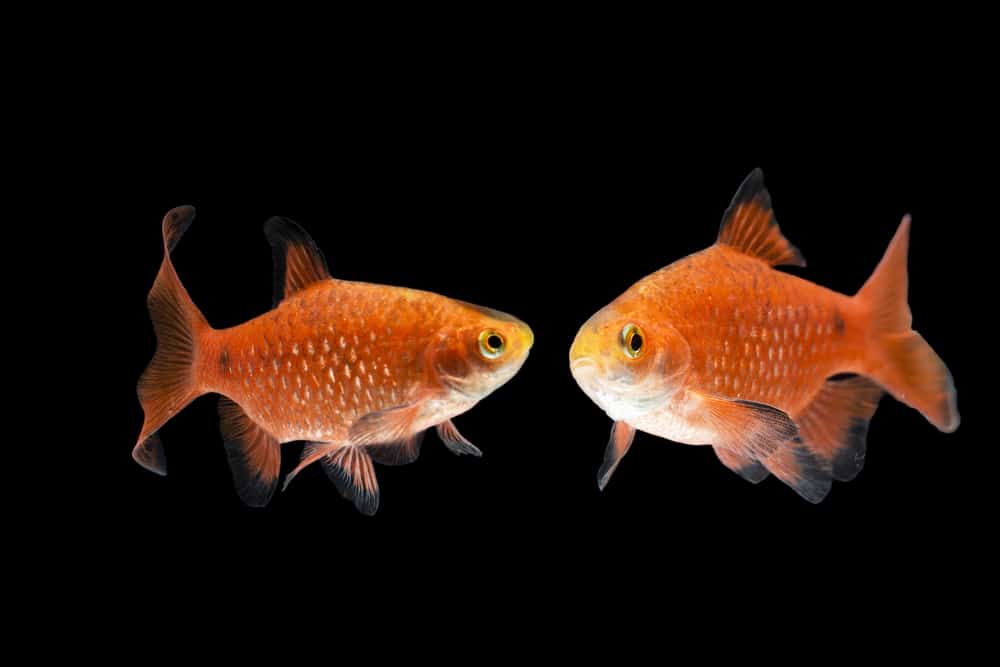
- Scientific Name: Puntius conchonius
- Common Names: Rosy barb
- Care Difficulty: Beginner
- Temperament: Peaceful
- Minimum Tank Size: 29 gallons
While they get larger than gold barbs, and most barbs for that matter, rosy barbs are not aggressive or fin nippers. Their size makes them more compatible with larger fish than other barbs, but otherwise has little impact on their care.
Rosy barbs are named for their stark red coloration and reflective scales, which shine a soft pink color. Other coloration is sparse and varies from fish to fish. But they all have a black dot at the beginning of their tail and black on the tips of their fins.
They are a joy to own, and will brighten any tank. They are hardy, not picky eaters, and work well in community tanks and with other peaceful fish.
Most are also able to live with semi-aggressive fish well. So options for tank mates are not as limited as they are with other barbs.
35. German Blue Ram
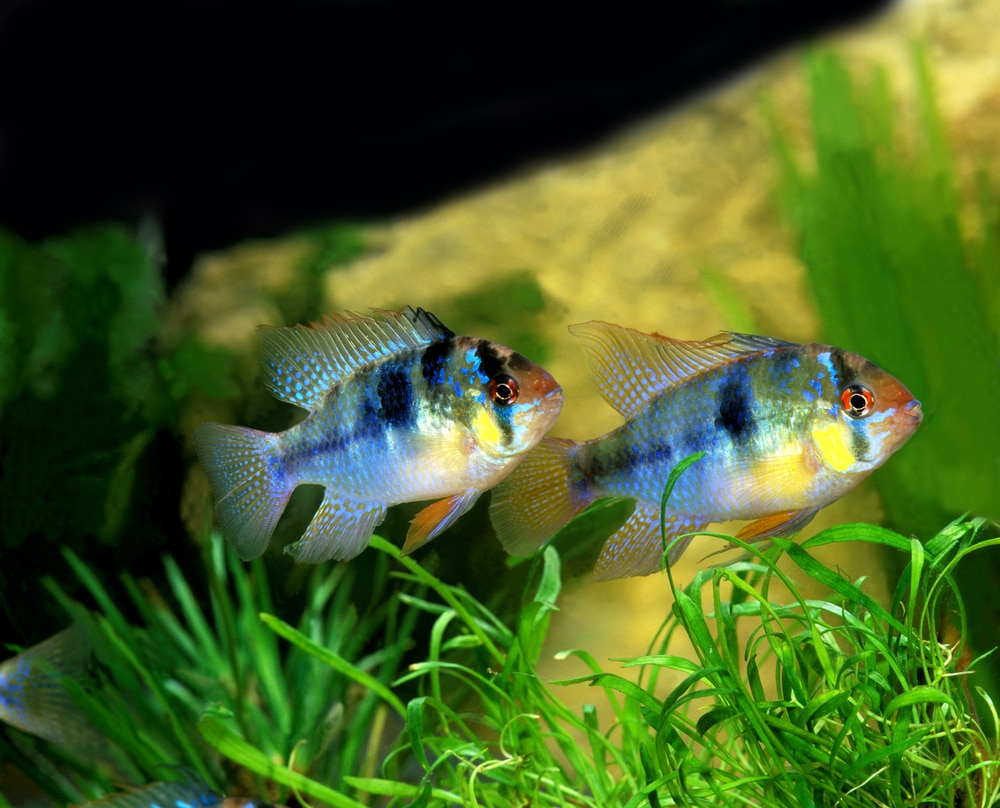
- Scientific Name: Mikrogeophagus ramirezi
- Common Names: German Blue Ram, Butterfly Cichlid, Ram Cichlid
- Care Difficulty: Moderate
- Temperament: Semi-Aggressive
- Minimum Tank Size: 20 gallons
German blue rams are some of the most beautiful beginner cichlids. They aren’t too aggressive and can be kept in both pairs and small groups.
Rams come in several color morphs, including golden rams, black rams, and a stunning electric blue color. Some can be picky with their food. But feeding them frozen treats 1-2x a week is enough to get them eating.
They will make some minor readjustments to the tank layout. Their latin name “Mikrogeophagus” means “little earth eater.” So expect to see some stones and gravel moved around every now and again.
Ram cichlids are somewhat sensitive when it comes to water parameters. They need neutral to acidic water (pH 5.5-7.0). Alkalinity lowers their lifespan and they won’t breed in hard water.
36. Cockatoo Cichlid
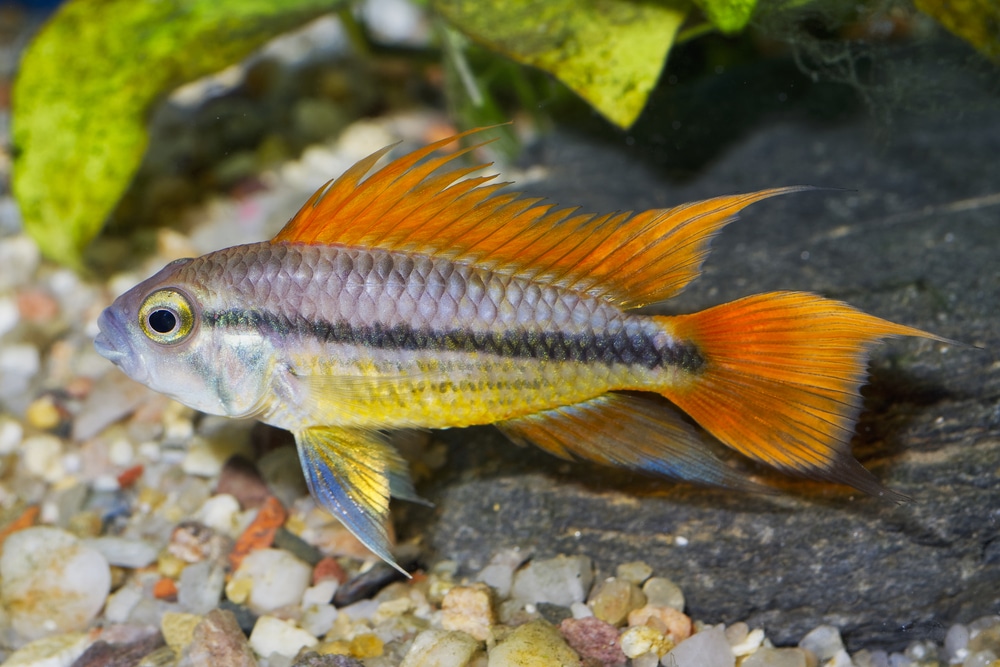
- Scientific Name: Apistogramma cacatuoides
- Common Names: Cockatoo Cichlid, Big Mouth Cichlid
- Care Difficulty: Beginner
- Temperament: Semi-Aggressive
- Minimum Tank Size: 29 gallons
Cockatoo cichlids are the most popular members of the genus Apistogramma. The entire group is found in South America and grows no larger than 2 to 3 inches.
While their bodies are tan/gray with one horizontal black stripe, their fins are black, splashed with orange, red and yellow in a bold, flame-like pattern. They are eye catching but also non-aggressive. They will get along with other fish well, except during breeding.
Cockatoo cichlids need a well decorated tank with several small caves and hides. They prefer tight fitting caves, and caves that only have one entrance/exit.
These cichlids are not demanding and do well in both species only and community tanks.
37. Jack Dempsey
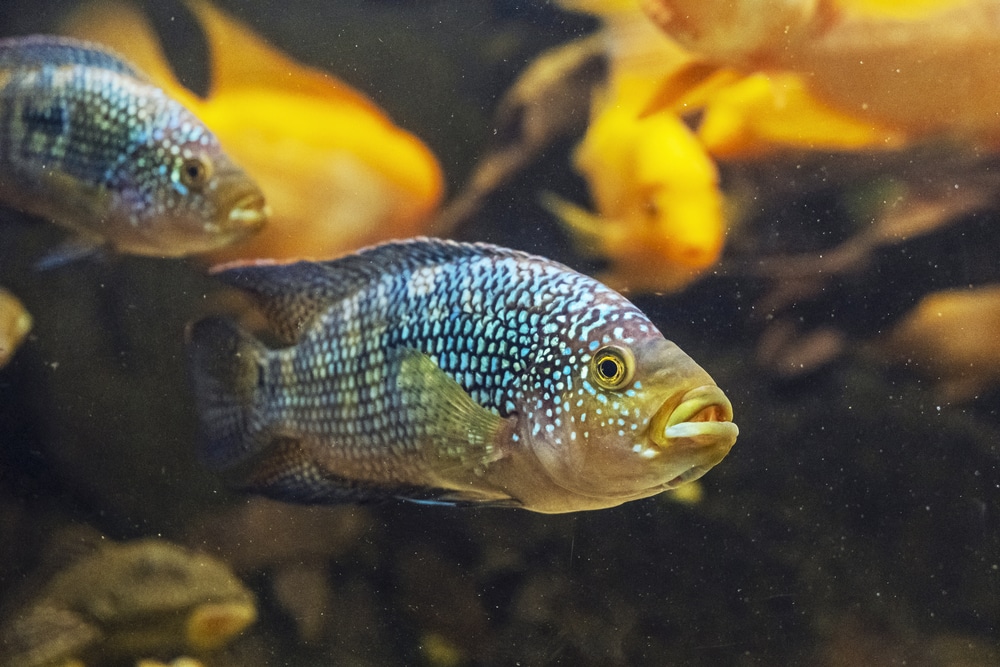
- Scientific Name: Rocio octofasciata
- Common Names: Jack Dempsey, Electric Blue Jack Dempsey
- Care Difficulty: Easy
- Temperament: Aggressive
- Minimum Tank Size: 55 gallons
Jack Dempsey cichlids are one of the larger species on this list. They are named after the famous boxer, who was known to be a vicious fighter.
Jack dempsies were one of the most aggressive fish around at the time of their discovery. But there are plenty of cichlids that are meaner than this fish. Dempsies are average in terms of temperament.
They do well alongside other Central American cichlids like Red Devils and Convict cichlids. Make sure the tank is spacious enough for all of the cichlids to claim a territory. Otherwise they will lip lock and wrestle for dominance.
Dempsies also come in an electric blue color morph. Blue dempsies are a little less hardy because they have been inbred for several generations to get those colors. So keep a close eye on nitrogenous waste levels.
38. Green Texas Cichlid
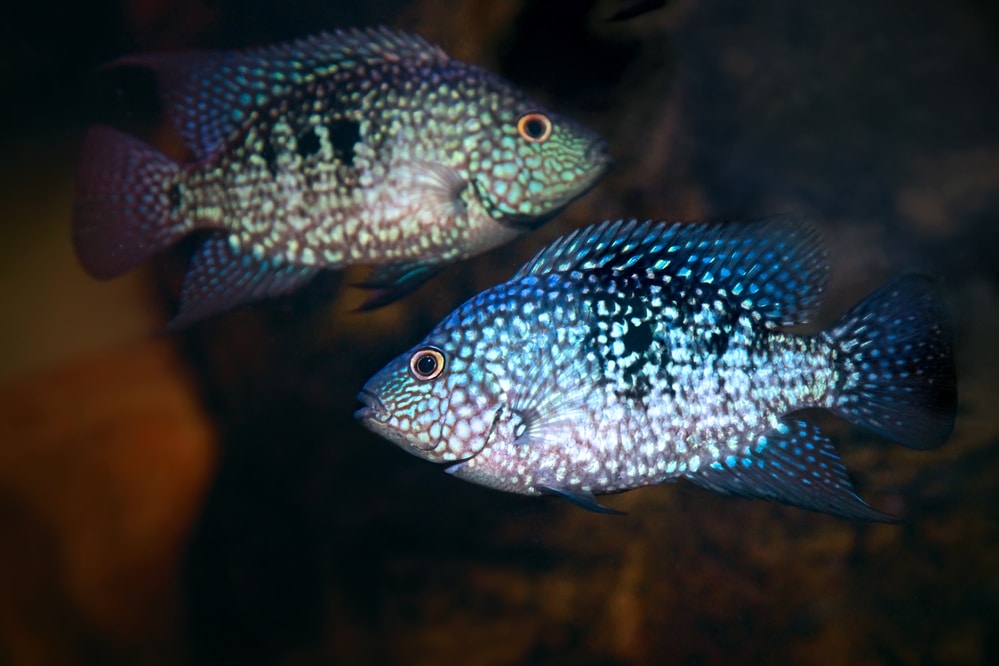
- Scientific Name: Herichthys cyanoguttatus
- Common Names: Green Texas Cichlid, Texas Cichlid
- Care Difficulty: Intermediate
- Temperament: Aggressive
- Minimum Tank Size: 60 gallons
Green Texas cichlids (also called Blue Texas cichlids) are like large, more colorful convict cichlids. They need the same hard, alkaline water conditions.
They will fight with each other and chase tank mates on occasion. But so long as your other fish are fast and the tank is spacious, no deaths will occur.
Texas cichlids are the only cichlid species native to the United States. You will see them in shallow bodies of water from Central Texas down into Mexico. So they don’t need tropical water conditions like other cichlids.
The green Texas cichlid is more expensive and harder to find than the standard Texas cichlid. But it’s bright green spangles, red eyes, and black background make it well worth the effort.
39. Odessa Barb
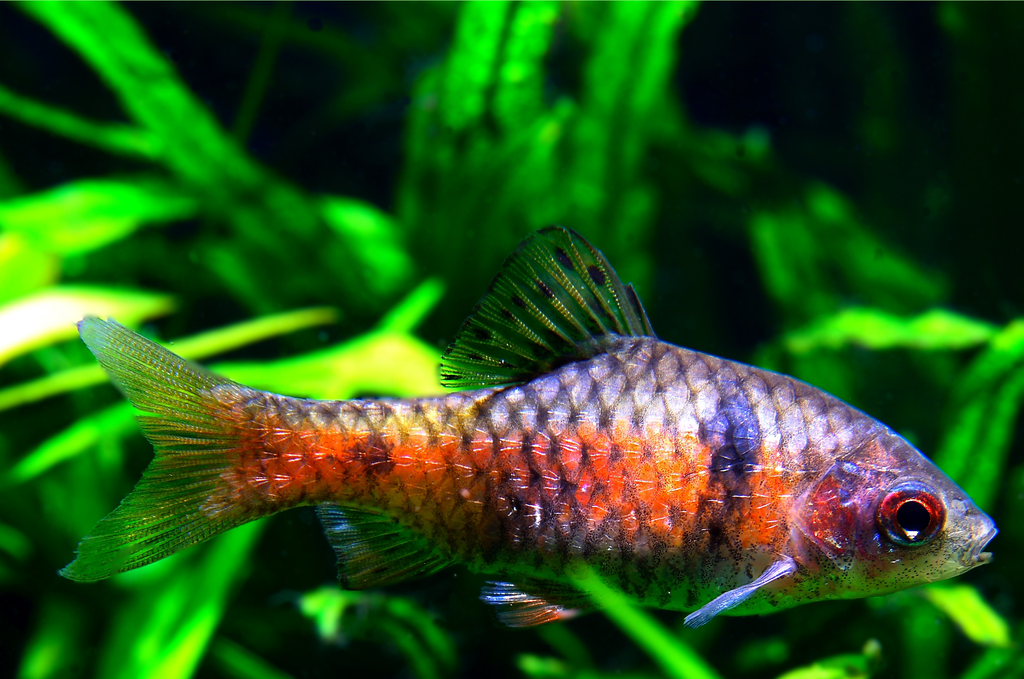
- Scientific Name: Pethia padamya
- Common Names: Odessa Barb, Scarlet Barb
- Care Difficulty: Beginner
- Temperament: Peaceful
- Minimum Tank Size: 30 gallons
Odessa barbs are silver bodied fish with a bold, horizontal red stripe from their head to their tail. Their scales are outlined in black, with some black appearing on the fins. And their iridescent scales make some scales appear white.
Odessa barbs are peaceful and hardy. And while they do best in planted tanks, this is not necessary for their overall wellbeing.
Since Odessa barbs are larger than most dither fish, they make good companions for medium to large cichlids.
40. Asian Stone Catfish
- Scientific Name: Hara jerdoni
- Common Names: Asian Stone Catfish, Stone Cat
- Care Difficulty: Beginner
- Temperament: Peaceful
- Minimum Tank Size: 10 gallons
One glance and it’s easy to see how the Asian stone catfish gets its name. Their rough outline and cryptic (camouflage) coloration helps them blend in among rocks and leaves along river bottoms.
While they do look exotic, Asian stone catfish are not difficult to care for. Ensuring they get enough to eat is the main issue. They are a shy and nocturnal species. Stone catfish will learn to eat during the day but prefer to dash back to their hiding places when finished.
Planted tanks with sandy bottoms and driftwood are their favored environment. Keep light levels low and add small, peaceful tank mates like tetras, cherry barbs, and dwarf gouramis.
41. Diamond Tetra
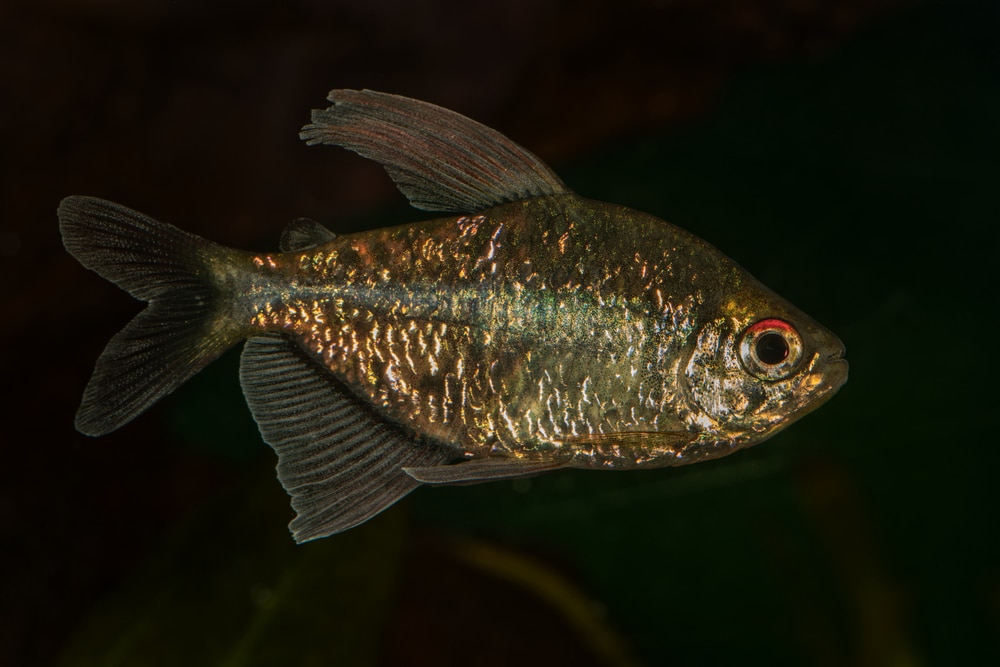
- Scientific Name: Moenkhausia pittieri
- Common Names: Diamond Tetra
- Care Difficulty: Intermediate
- Temperament: Peaceful
- Minimum Tank Size: 29 gallons
Diamond tetras get their name from their bright, shiny scales and rhomboid body shape. Their red eyes and flowing fins add to their appeal. And if you provide good water conditions and low light, diamond tetras take on soft purple and green colors.
Like all Amazonian tetras, the diamond tetra needs soft, acidic to neutral water to thrive (pH 5.5-7.0). They are carnivores and should be fed brine shrimp, tubifex worms, and other treats. Along with flakes and micro pellets.
Diamond tetras are sensitive to elevated ammonia and nitrite levels. But so long as your tank is cycled and well filtered, you won’t have issues in keeping them.
42. Cardinal Tetra
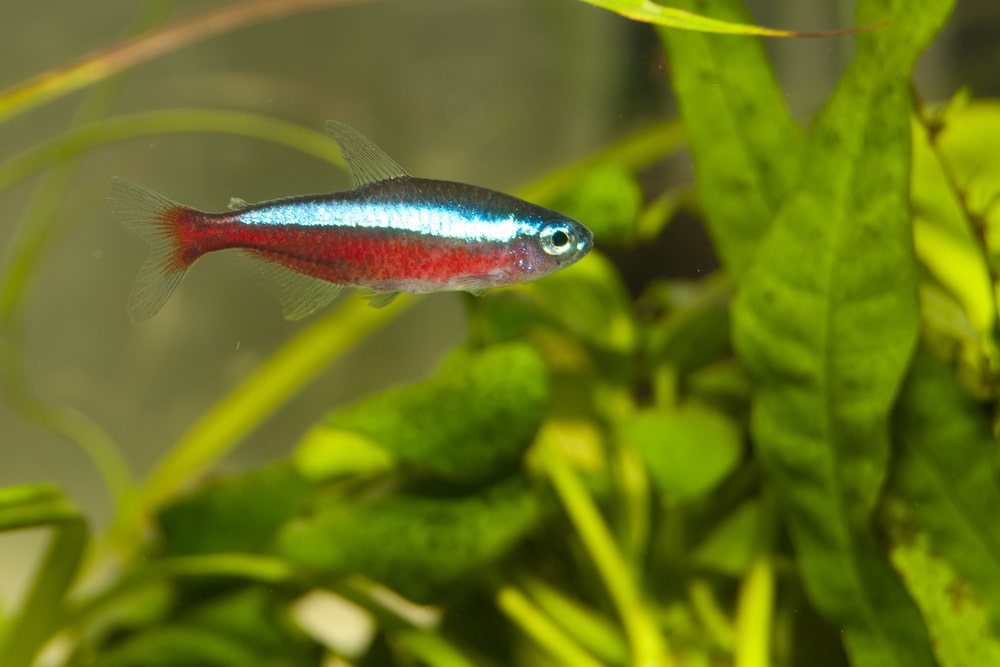
- Scientific Name: Paracheirodon axelrodi
- Common Names: Cardinal Tetra, Red Neon
- Care Difficulty: Beginner
- Temperament: Peaceful
- Minimum Tank Size: 20 gallons
Cardinal tetras are similar to their close cousin the neon tetra. But they aren’t too difficult to tell apart. Cardinal tetras have a longer red stripe. They also grow larger, reaching up to 2 inches in length.
Cardinal tetras are all wild caught so they aren’t as hardy as captive bred neon tetras. You must provide them with acidic, even blackwater conditions (pH 4.0-6.5) or they are likely to die.
Temperatures should remain high (75-85℉) and the water should be rich in plant tannins. Adding driftwood and Indian almond leaves will help with this.
Cardinal tetras require schools of at least six and should only be housed with other peaceful tank mates. They are often kept in community planted tanks, as their blue and red stands out against green plants.
43. Blood Parrot Cichlid
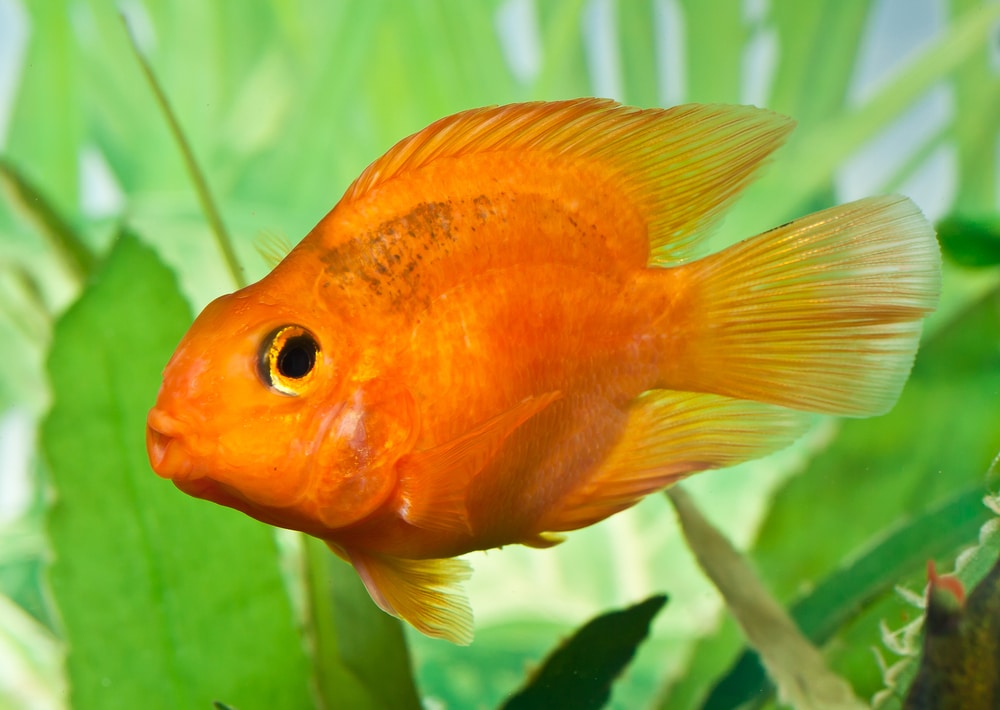
- Scientific Name: Amphilophus citrinellus x Paraneetroplus synspilus
- Common Names: Blood Parrot Cichlid, BP, Bloody Parrot
- Care Difficulty: Intermediate
- Temperament: Peaceful
- Minimum Tank Size: 55 gallons
Blood parrot cichlids are a controversial choice. They are hybrid fish with a genetic deformity. Their bodies aren’t shaped that way by nature but it does not interfere too much with their ability to eat.
Parrot cichlids are descended from aggressive species. But their mouths are too small to cause harm to their tank mates. You may see them try and chase other fish around, regardless.
Feed them a carnivorous diet with pellets or flakes small enough for them. Blood parrot cichlids reach up to 8 inches long and do well with peaceful to semi-aggressive tank mates.
44. Rainbow Shark
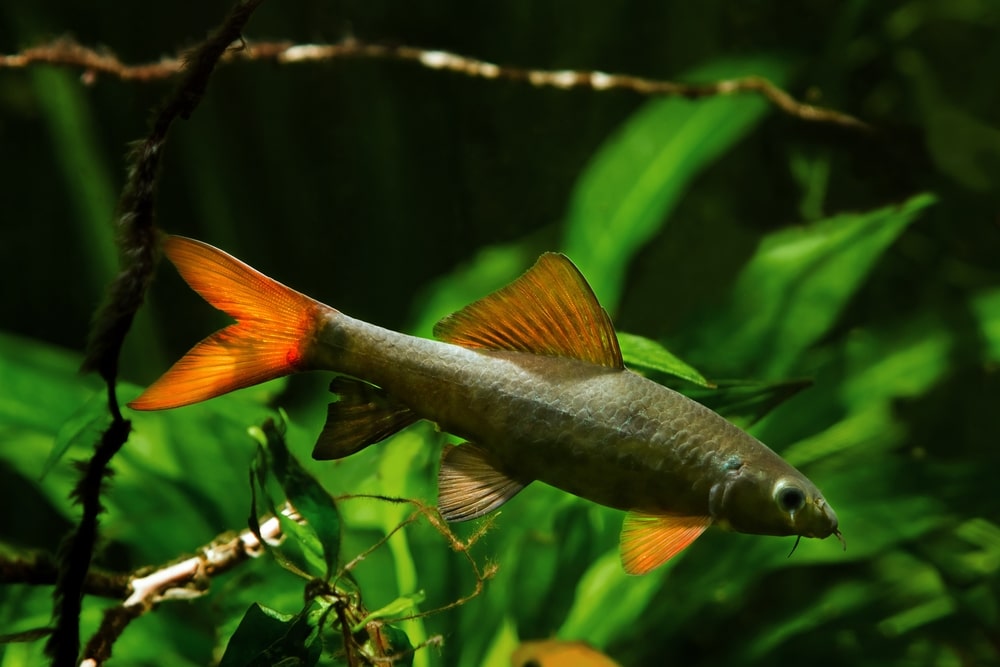
- Scientific Name: Epalzeorhynchos frenatum
- Common Names: Rainbow shark, Red Fin Shark
- Care Difficulty: Beginner
- Temperament: Semi-Aggressive
- Minimum Tank Size: 55 gallons
Rainbow sharks are a popular freshwater fish that come in three main varieties: the common form, an albino rainbow shark, and a glofish breed.
Decorations are a must for this fish. They are semi-aggressive and territorial, and they need decorations to build their territory around.
Without any decorations, they will claim the entire tank as their territory. Which will cause severe aggression issues with any other fish.
Don’t try keeping more than one rainbow shark together. These fish are too aggressive and one will kill the other.
Rainbow sharks are otherwise easy to care for. They will eat pellets and flakes that reach the bottom. Rainbow sharks also feed on green hair algae and biofilm that grows on decorations.
45. Black Skirt Tetra
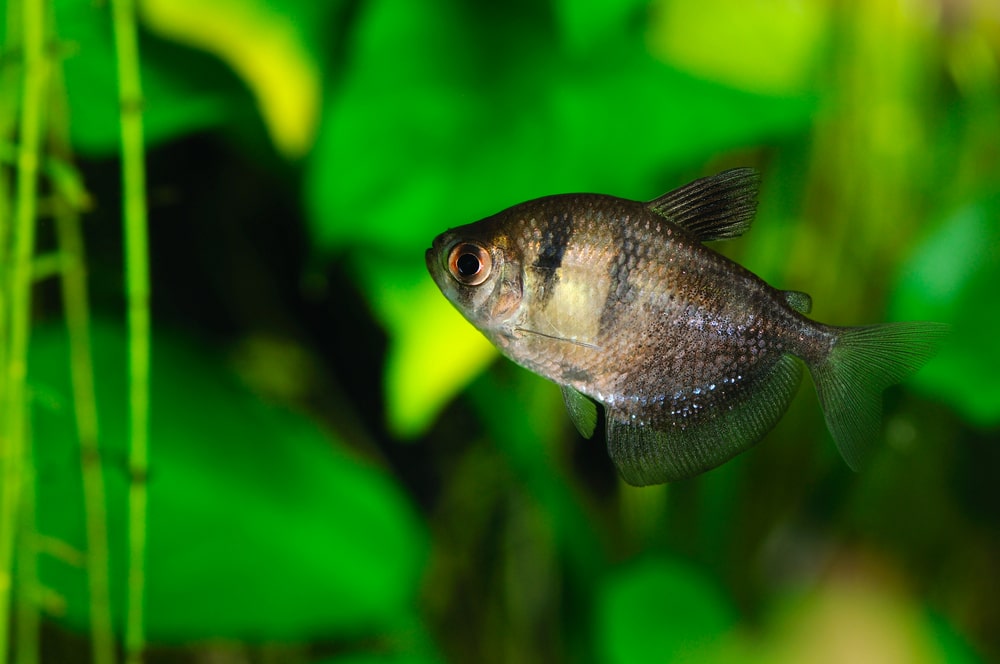
- Scientific Name: Gymnocorymbus ternetzi
- Common Names: Black Skirt tetra, Black Widow tetra, gold skirt tetra
- Care Difficulty: Beginner
- Temperament: Peaceful
- Minimum Tank Size: 20 gallons
Black skirt tetras are a hardy, chunky bodied tetra. They get their name from their anal fin, which is longer in males and looks like a skirt.
Since they are a schooling species, they need a group of at least 6 to feel secure. Black skirt tetras are known to be fin nippers. So avoid keeping them with bettas, angelfish, and other tempting targets.
Some black skirt tetras are colored using artificial dyes. They will either lose their color or live shorter life spans.
The glo-fish versions of black skirt tetras are different, however. Their colors come from being gene edited to produce fluorescent proteins. Glofish tetras live normal lives and have no side effects from their coloration.
46. Bloodfin Tetra
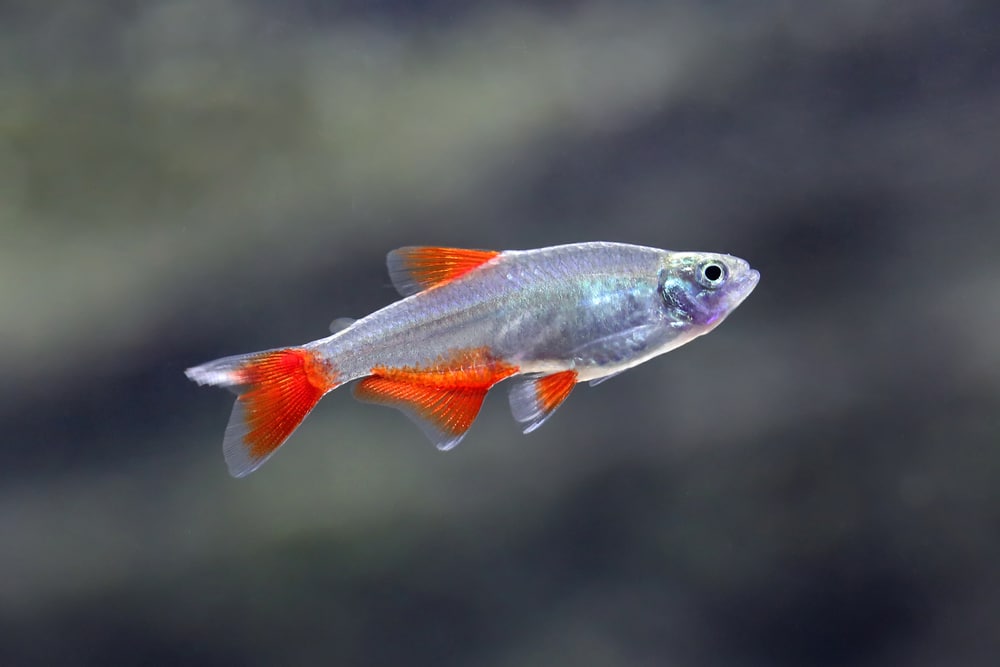
- Scientific Name: Aphyocharax anisitsi
- Common Names: Bloodfin tetra
- Care Difficulty: Beginner
- Temperament: Peaceful
- Minimum Tank Size: 20 gallons
Bloodfin tetras are aptly named, because while their bodies are a plain silver, their fins are a stark red.
Like most tetras, the bloodfin tetra is a peaceful community tank resident. They are also one of the few tetras that do well in colder water conditions. Since they come from Argentina, they prefer a temperature range of 64-75℉.
Bloodfin tetras are undemanding but sensitive to ammonia and other nitrogenous waste. Add them last to any new aquarium.
47. Redeye Tetra
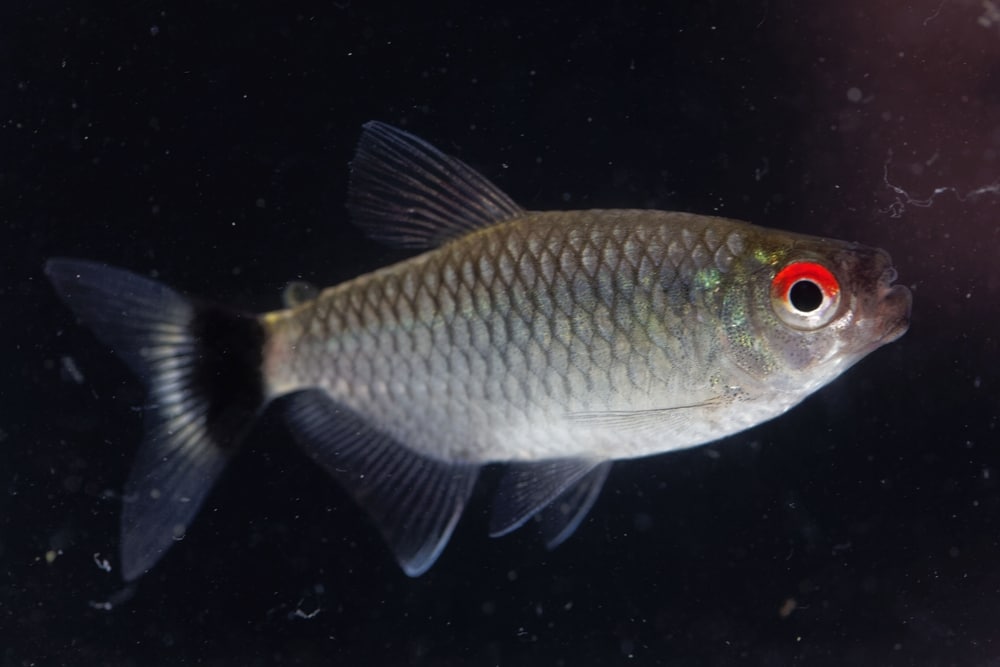
- Scientific Name: Moenkhausia sanctaefilomenae
- Common Names: Redeye tetra, lampeye tetra
- Care Difficulty: Beginner
- Temperament: Peaceful
- Minimum Tank Size: 20 gallons
Redeye tetras are a silver bodied fish with a red ring around their eyes with two vertical bands on their tail, one white and one red. Although this sounds like a plain looking fish, once in a school, their red eyes stand out in a unique way.
Redeye tetras prefer planted tanks with lush vegetation. They are a hardy but shy species. And extra cover nearby helps them feel secure enough to venture out into the open.
Most tetras are challenging to spawn. But the redeye is an exception. Even beginner aquarists have a chance at breeding them.
48. Raphael Catfish
- Scientific Name: Platydoras armatulus
- Common Names: Raphael Catfish, Striped Raphael Catfish
- Care Difficulty: Intermediate
- Temperament: Peaceful
- Minimum Tank Size: 29 gallons
The Raphael Catfish has alternating black and cream horizontal stripes across its body, coupled with very long barbels and fins. While they are exotic looking, these catfish are good inhabitants for community tanks with medium sized fish.
Be careful when using a net on them. Their long fins and hidden spines can easily get stuck in the net, trapping the fish.
Raphael catfish are also not particularly active, and spend much of their time hiding in decorations, plants, and driftwood.
Be sure to drop extra food in the tank about an hour after the lights go off. By doing so the catfish have a chance to eat without another fish snatching up their food.
49. Glass Catfish
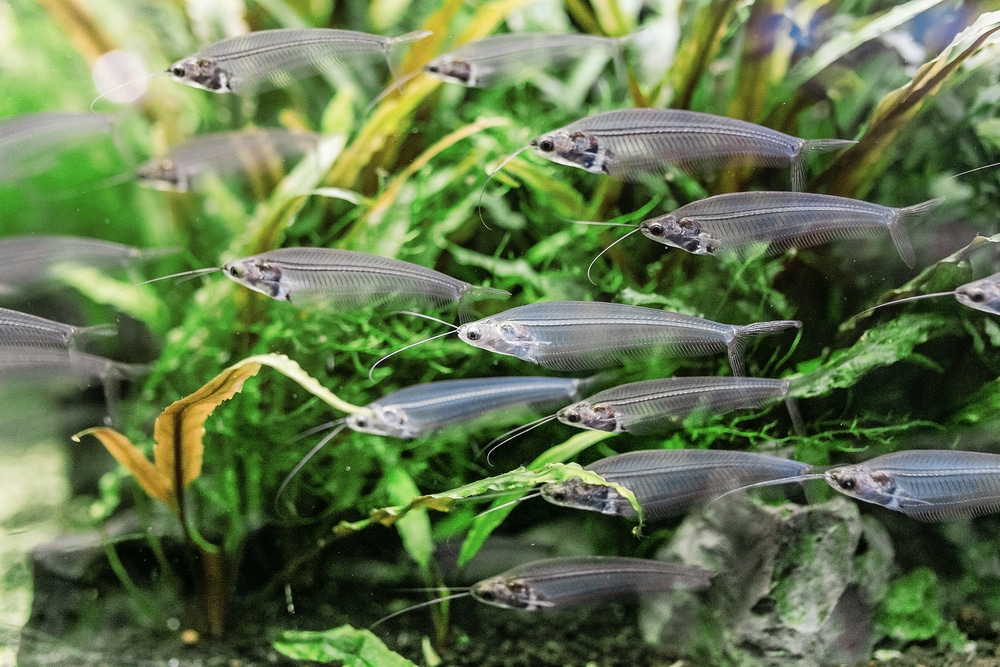
- Scientific Name: Kryptopterus vitreolus
- Common Names: Glass catfish, glass cat, phantom catfish
- Care Difficulty: Intermediate
- Temperament: Peaceful
- Minimum Tank Size: 29 gallons
Glass catfish are transparent fish thanks to their complete lack of pigmentation. Their bones, body cavity, and organs are all visible. There are a few species but the one most common in the hobby is Kryptopterus vitreolus.
Glass catfish require schools of 6 or more and do best in aquariums with plenty of plants and other decorations. They are a shy, skittish species. Without enough hiding areas, they will be stressed, even in a community tank.
These catfish are more sensitive to fluctuations in water parameters, primarily hardness and pH. So be sure to acclimate this fish to their new home slower than you would with other fish.
Large water changes over 50% may also cause stress. So it is best to change around 20% weekly, depending on your nitrate levels.
Glass catfish are sometimes predatory towards tiny fish like young guppies or tetras. But they are otherwise peaceful towards their tank mates.
50. Otocinclus
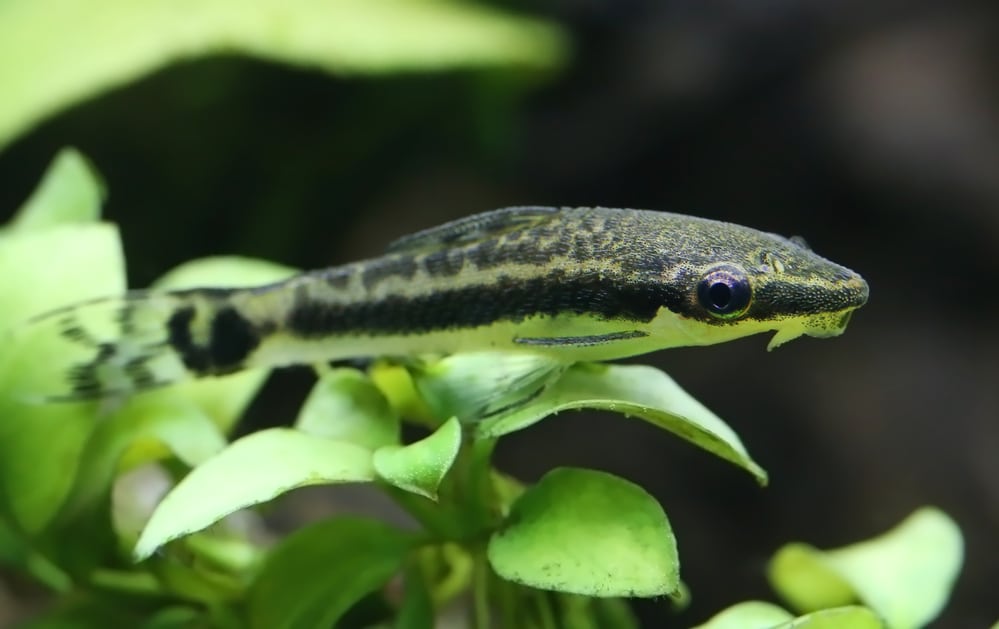
- Scientific Name: Otocinclus
- Common Names: Otocinclus, Oto, Dwarf Sucker
- Care Difficulty: Intermediate
- Temperament: Peaceful
- Minimum Tank Size: 20 gallons
The Otocinclus catfish, or “Oto” for short, is a tiny catfish that has cream, brown, and black coloration. These freshwater aquarium fish prefer being kept in small groups or even schools of 10 or more.
Otos have a symbiotic relationship with bacteria in their gut; they primarily feed on plant matter and algae but are unable to digest this. The bacteria will digest it for them, and both species are benefited.
Otocinclus are excellent algae eaters. They are gentle at cleaning algae from the leaves of Cabomba and other soft, delicate plant species.
Besides algae, you should feed them algae wafers and blanched vegetables. Clip veggies in place along the glass close to the bottom of the tank.
Dwarf otos are peaceful and do well with fish their own size. They are also good tank mates for dwarf freshwater shrimp.
51. Freshwater Stingrays
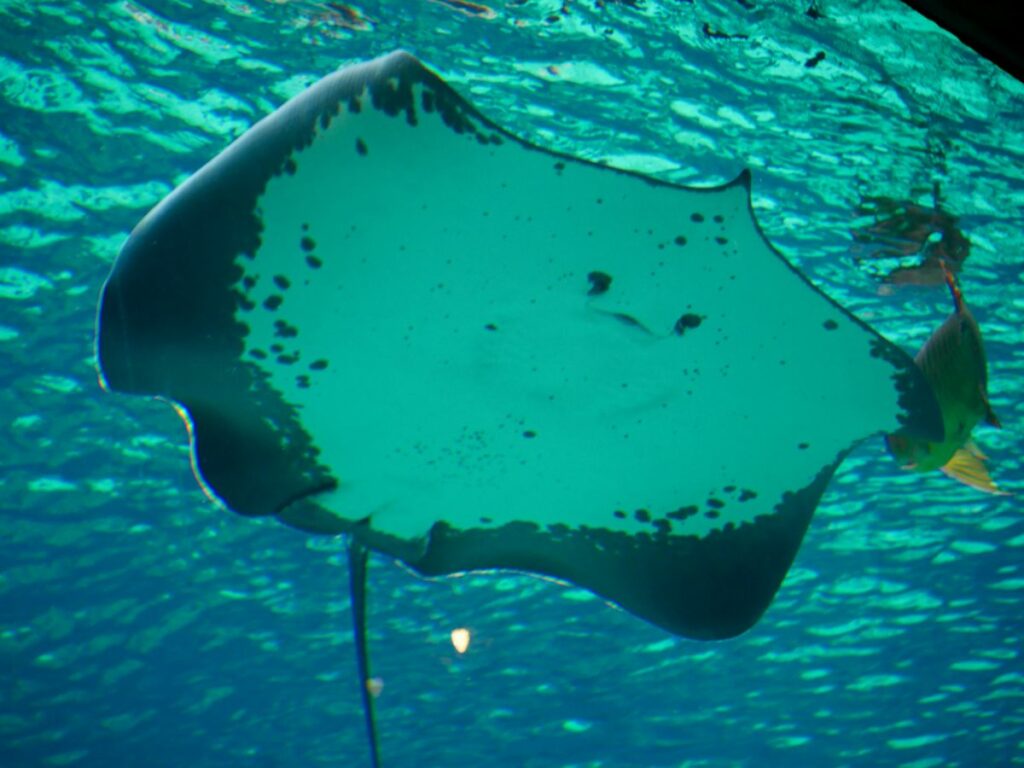
- Scientific Name: family Potamotrygonidae
- Common Names: Freshwater Stingray
- Care Difficulty: Intermediate to Difficult
- Temperament: Peaceful; Predatory
- Minimum Tank Size: 125 gallons
Freshwater stingrays are not a beginner freshwater aquarium fish. They are expensive, predatory, and sensitive to poor water quality. But few fish are so fascinating in behavior.
Stingrays are related to sharks and other cartilaginous fish. They do have a venomous barb along their tails, used in defense. The venom is not known to be deadly to humans but it is painful.
You need an ample supply of meat-based food for these carnivorous fish. They are messy eaters, getting crumbs of flesh everywhere when they chew. Stingrays also produce a lot of ammonia as waste. Large canister filters are required, along with a large tank with a sand substrate for them to bury themselves in.
52. Chili Rasbora
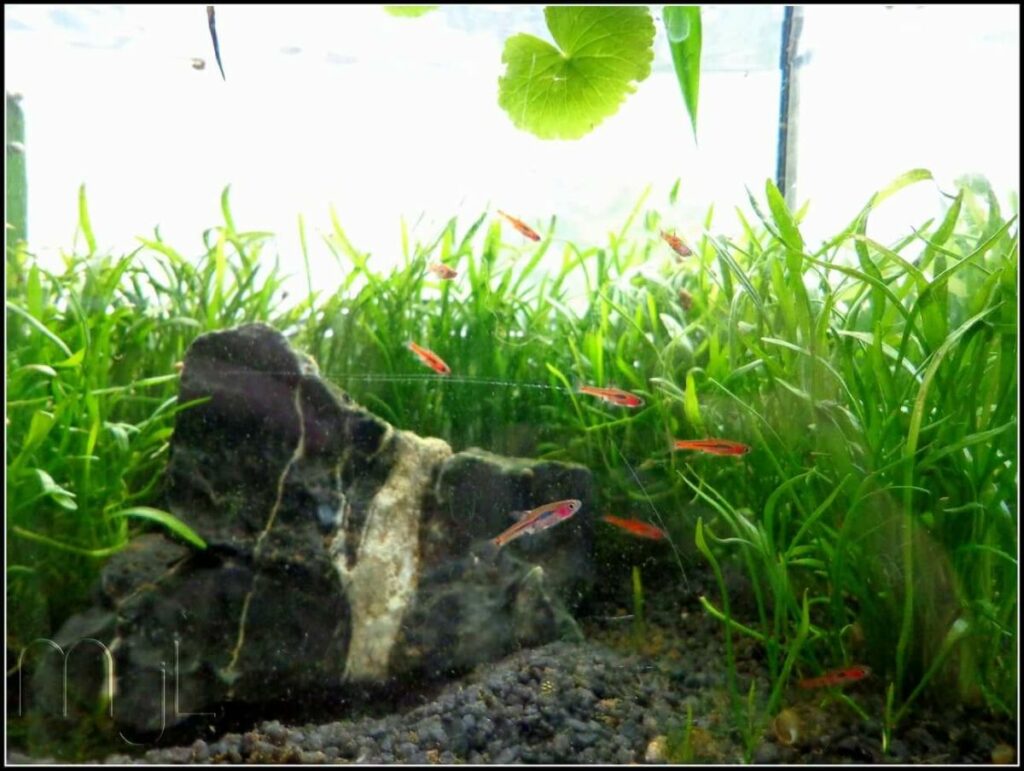
- Scientific Name: Boraras brigittae
- Common Names: Chili rasbora; Mosquito rasbora
- Care Difficulty: Intermediate
- Temperament: Peaceful; Schooling
- Minimum Tank Size: 5 gallons
Chili rasboras are a species of nano aquarium fish; those that stay under 1 inch in length. They come from the blackwater swamps of Southeast Asia. Here, the pH is as low as 4.0 and the waters are dark with decaying plant debris.
Since they are so tiny, keep chili rasboras with dwarf shrimp, small tetras, and other tank mates. Even a betta is large enough to eat them.
As shoaling fish, chili rasboras should be kept in groups of at least 6 individuals. given how small they are, you should be able to double this, even in a 5 gallon tank. Their individual bioload is minimal.
Feed them baby brine shrimp, powdered flake food, and other small items. When kept in a planted tank with low light, chili rasboras show an intense red glow with purple iridescence.
53. Pea Puffer
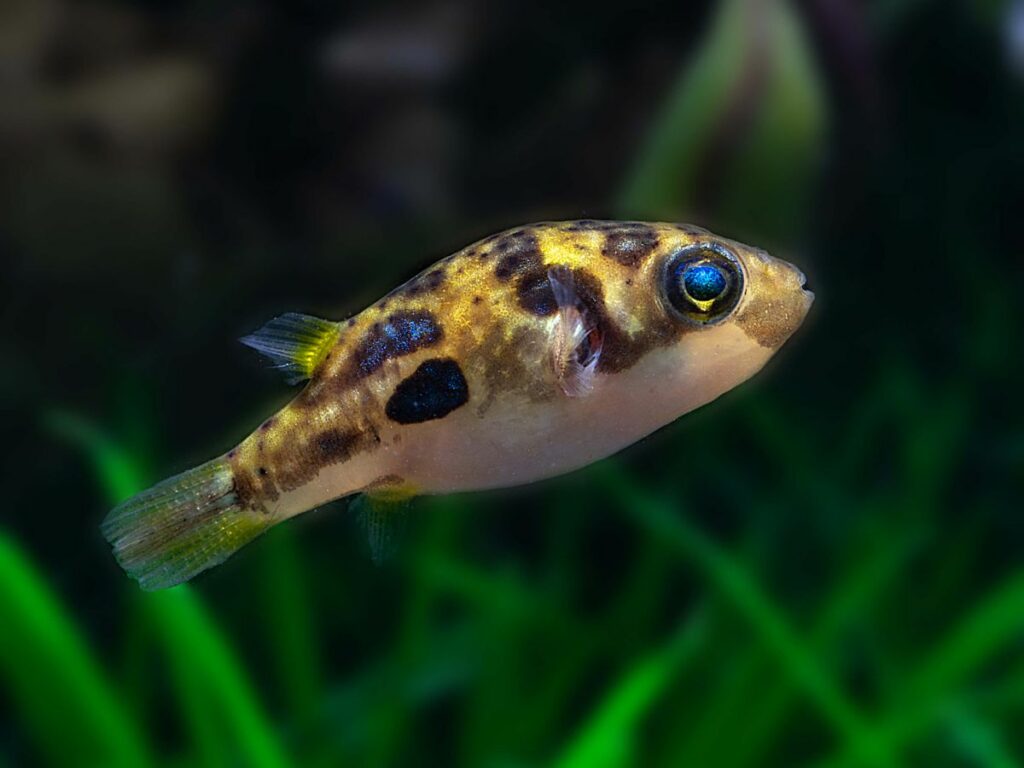
- Scientific Name: Carinotetraodon travancoricus
- Common Names: Pea Puffer; Dwarf Puffer; Malabar Puffer
- Care Difficulty: Intermediate
- Temperament: Aggressive; Territorial
- Minimum Tank Size: 10 gallons
Puffer fish tend to be large, aggressive fish that have to live by themselves. But the Pea Puffer is a rare exception. At least when it comes to their size; adults are 3/4 to 1 inch long.
That said, Pea puffers do tend to be a lot more aggressive than you’d expect for such a small fish. They will nip the fins of slower tank mates. Pea puffers will even bite at the eyes and whiskers of sleeping catfish.
They are predators of invertebrates so keep them away from shrimp and snails. pea puffers do best in a species-only tank. Or alongside tetras and other fast-moving fish in a spacious community tank.
54. Dwarf Crayfish
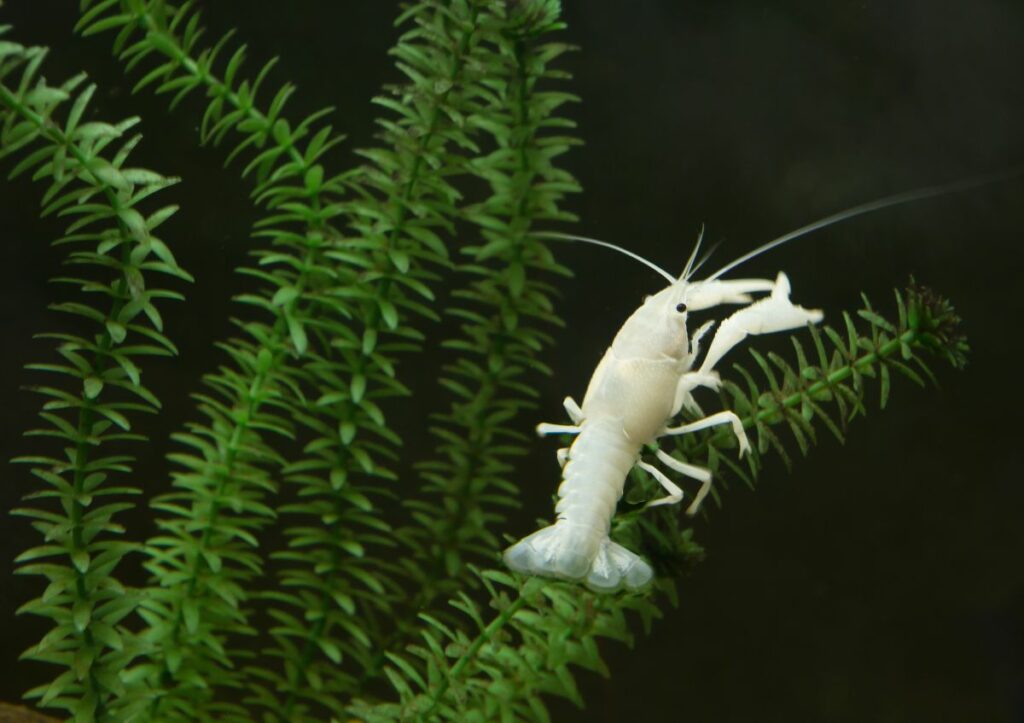
- Scientific Name: Cambarellus sp.
- Common Names: Dwarf Crayfish
- Care Difficulty: Easy
- Temperament: Peaceful
- Minimum Tank Size: 5 gallons
Crayfish don’t belong in most aquariums with fish. They are too large and too omnivorous. An adult crayfish will eat anything it can grab. Dwarf crayfish are an exception, however.
These little crayfish stay an inch long, too small to threaten their tank mates. A molting dwarf shrimp may be on the menu. But even tetras and guppies are safe from them.
Since they are so small, make sure their tank mates are about the same size. Feed your dwarf crayfish anything organic. Fallen flakes, pellets, brine shrimp, bloodworms…They eat anything they can get ahold of.
55. Silver Arowana
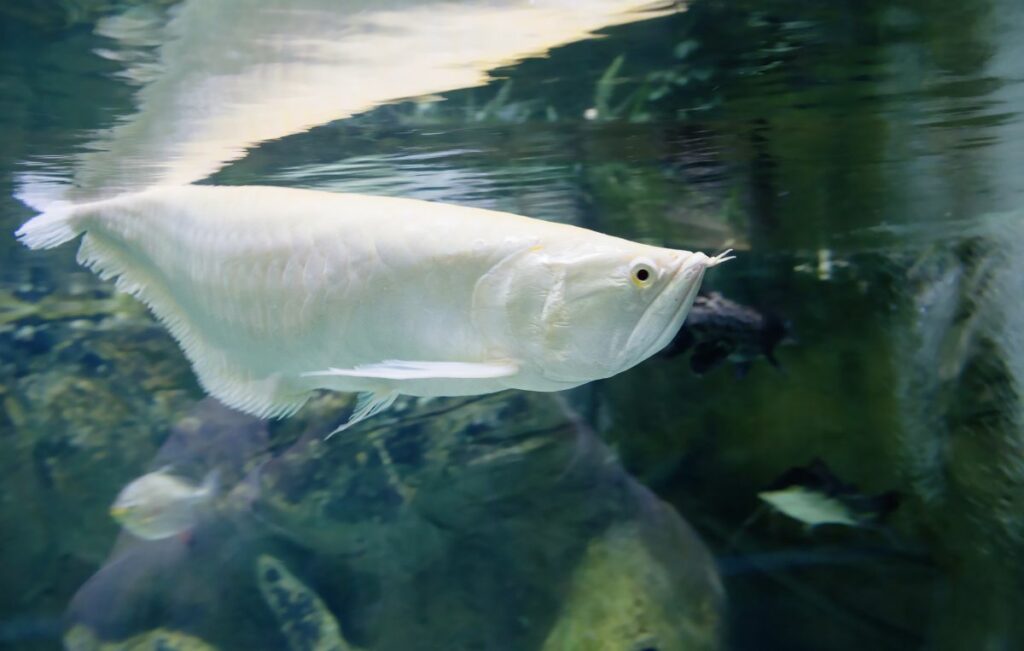
- Scientific Name: Osteoglossum bicirrhosum
- Common Names: Silver Arowana
- Care Difficulty: Easy to Intermediate
- Temperament: Semi-Aggressive; Predatory
- Minimum Tank Size: 240+ gallons
Monster fish keepers often start out with the silver arowanas before moving onto bigger species. They are easy to find when a few inches long. Yet they reach their adult size in just a few years.
Arowanas aren’t difficult to keep in terms of hardiness. They are resistant to nitrogenous waste and eat anything that fits in their huge mouths. The main problem is their size.
Silver Arowanas reach 3 feet long as adults and require a massive tank. All arowanas are excellent jumpers, as well. In the wild, they will leap to catch insects and even lizards on tree branches. A secure lid is needed since they are powerful enough to dislodge one that isn’t fastened onto the tank.
While they do prefer live prey, arowanas are easy to train onto pellets. You should supplement prepared items with sliced fish, crickets, and other fresh food a few times per week.
56. Twig Catfish
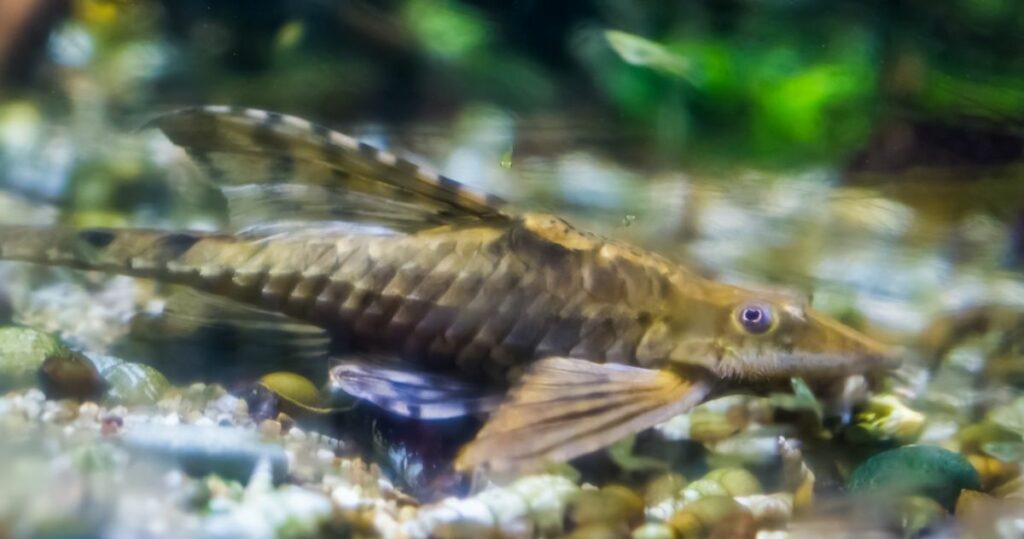
- Scientific Name: Farlowella sp.
- Common Names: Twig Catfish, Royal Farlowella
- Care Difficulty: Easy to Intermediate
- Temperament: Peaceful
- Minimum Tank Size: 20+ gallons
Twig catfish are loricariid catfish and in the same family as both plecostomus and dwarf otocinclus. They have a different look as they evolved to mimic sunken twigs. Twig catfish are a reclusive species and prefer planted tanks with lower light levels.
They are active at dawn and dusk, feeding on the green algae and biofilm that grows on plant leaves, driftwood, and aquarium glass. While they look exotic, twig catfish aren’t hard to care for. They are peaceful and should be kept with small to medium sized tank mates.
Amazonian fish like angelfish, discus, cardinal tetras, and corydoras are best. All of these fish enjoy the same soft, acidic water conditions that twig catfish do. They are all peaceful community fish as well.
57. Scarlet Badis
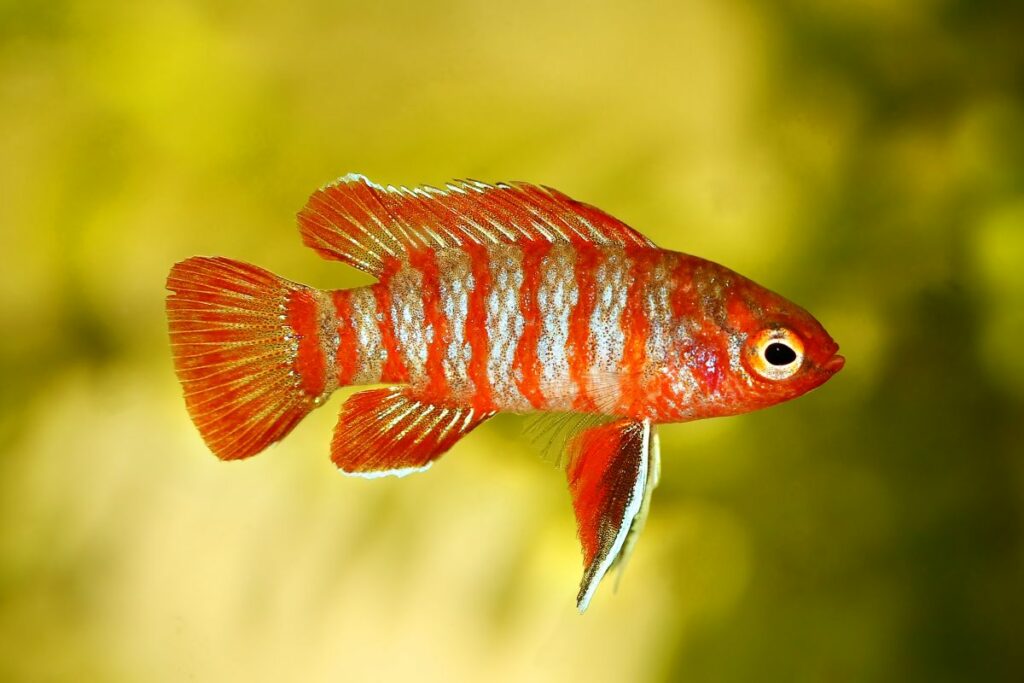
- Scientific Name: Dario dario
- Common Names: Scarlet Badis, Scarlet Gem Badis, Rainbow Badis, Bengal Badis
- Care Difficulty: Easy
- Temperament: Semi-Aggressive; Territorial
- Minimum Tank Size: 10-20 gallons
Scarlet badis are a small yet colorful freshwater aquarium fish. The males are a bright red color, with blue tipped fins while the females are a dull grey or brown. If you want to see their best colors, you will need to keep a few females. Males color up to impress possible mates.
Scarlet badis are peaceful towards most fish but aggressive towards each other. The males will fight. But so long as you give each of these small fish 10 gallons of space per male, the loser will have room to retreat.
An alternative approach is to keep a colony of male Scarlet badis. Similar to how you’d group African mbuna cichlids. They will spread their aggression out so much that no one fish will be targeted to death.
58. Amazon Leaf Fish
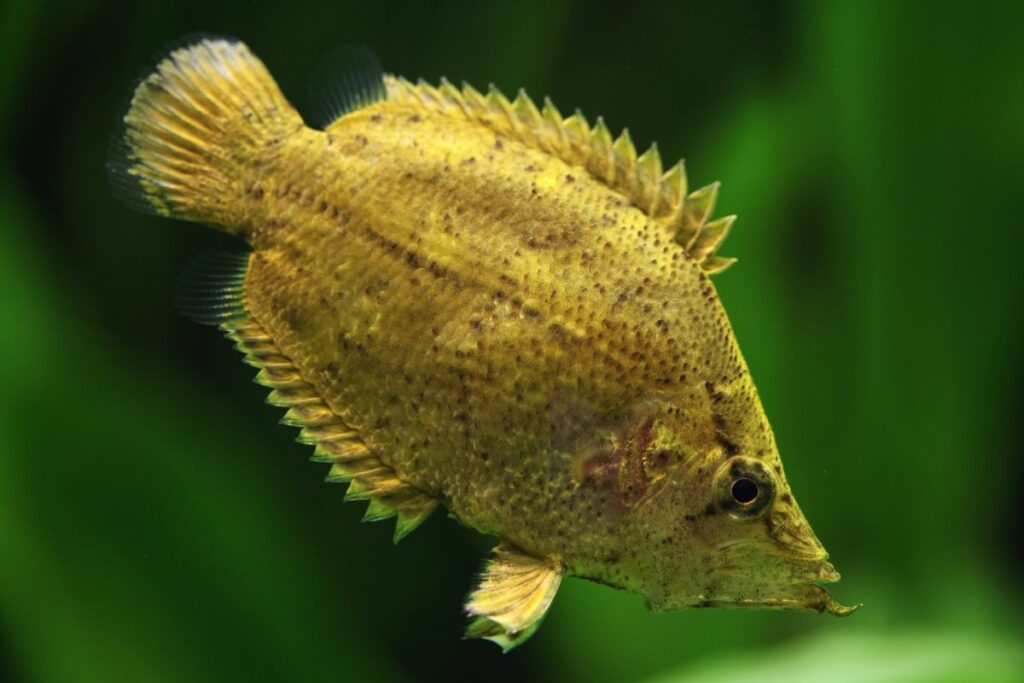
- Scientific Name: Monocirrhus polyacanthus
- Common Names: Amazon Leaf Fish, South American Leaf Fish
- Care Difficulty: Intermediate
- Temperament: Peaceful; Predatory
- Minimum Tank Size: 30 gallons
Not all predatory freshwater aquarium fish are large. The Amazon Leaf fish is a specialist predator that grows no larger than 3 inches long. Its body color and shape is a testament to the selective power of evolution. The fish has a mottled, cryptic color and a leaf-shaped body, complete with a stem on its lower jaw.
Amazon Leaf fish will waft along the current, waiting for a small fish, insect, or shrimp to get too close. They then extend their mouths to create a vacuum, sucking their prey in from a fair distance.
These fish should be fed live food. Feeder guppies, tubifex worms, and other small prey work best. Since they are wild caught Amazon Leaf fish are difficult to wean onto pellets and flakes.
59. Black Ghost Knifefish
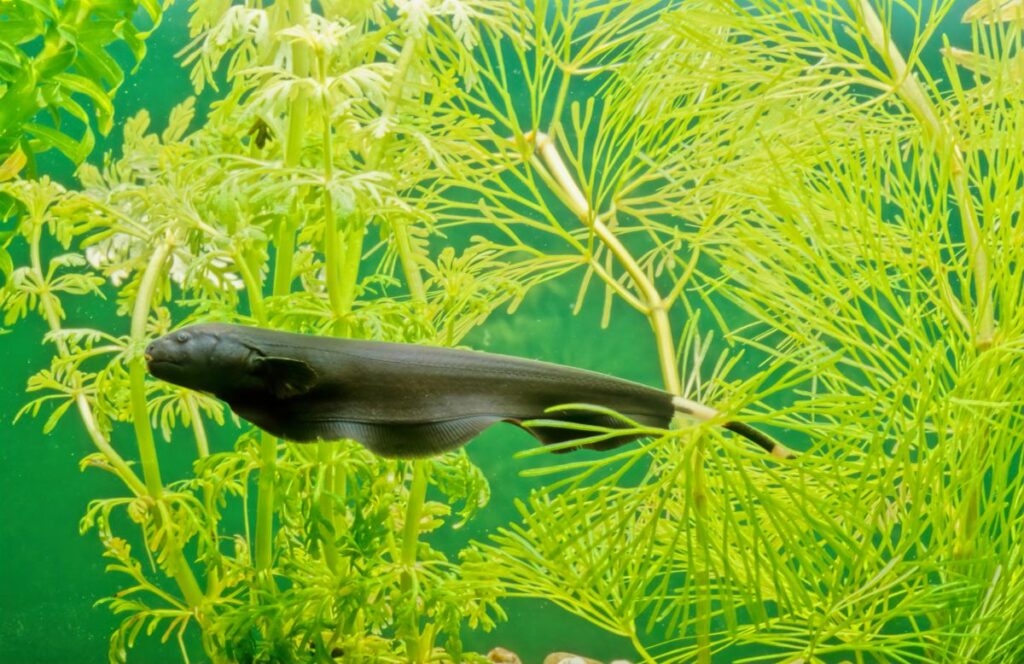
- Scientific Name: Apteronotus albifrons
- Common Names: Black Ghost Knifefish
- Care Difficulty: Intermediate
- Temperament: Peaceful; Predatory
- Minimum Tank Size: 100 gallons
Black ghost knifefish are one of the few electric freshwater aquarium fish in the hobby. They aren’t strong enough to electrocute you and cause pain, like the electric eel or electric catfish.
Knifefish use their electricity as a navigational aid. They are nocturnal fish and live in dark, murky water. Instead of relying on their tiny eyes, Black Ghost Knifefish can sense objects using their electricity field. Nearby prey is also detectable through the electrical activity of muscle twitches.
Black Ghost Knifefish are predators but of small fish, worms, and shrimp. They are peaceful towards their tank mates but they do need a cave to hide in during the day. A PVC tube works best since it prevents nearby fish from activating their electrical field while they sleep.
60. Red Devil Cichlid
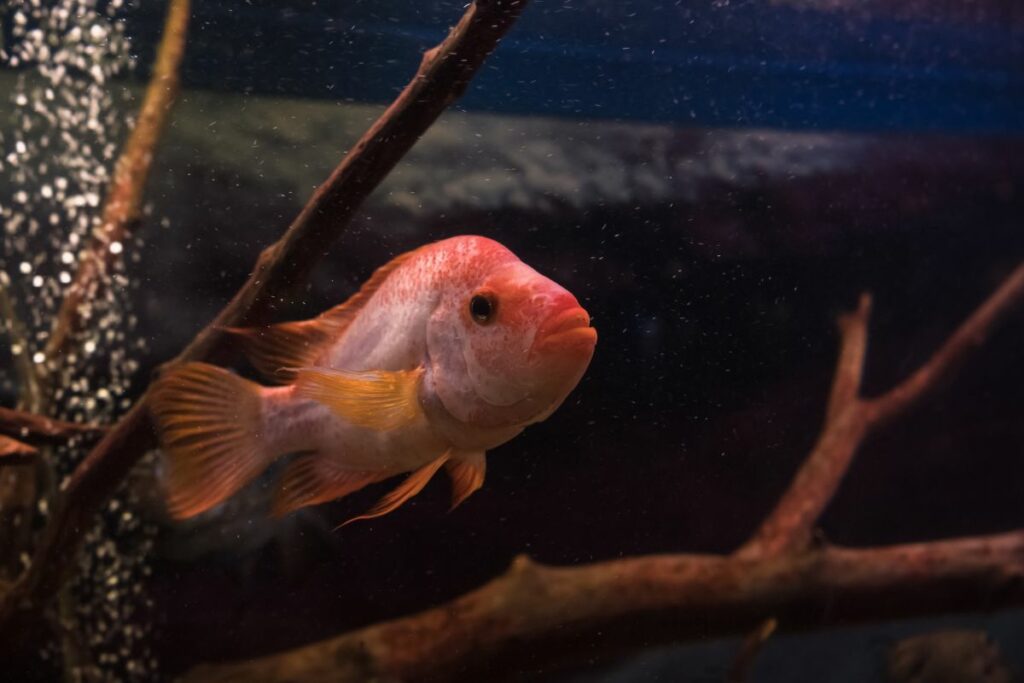
- Scientific Name: Amphilophus labiatus
- Common Names: Red Devil Cichlid; Red Devil Fish
- Care Difficulty: Easy
- Temperament: Aggressive
- Minimum Tank Size: 75+ gallons
Red Devil cichlids are the most aggressive freshwater aquarium fish on this list. They are a Central American cichlid that will reach 15 inches when full grown.
Red Devils are not difficult in terms of overall care. They are hardy fish that thrive in mineral-rich, alkaline tap water. Red Devils eat flakes when young and pellets with gusto as an adult.
They will redecorate your tank, however. Red Devil cichlids dig all of the time and make big piles out of your substrate. Any plants will be torn up and chewed on.
Tank mates need to be chosen with care because these cichlids are vicious. If the tank is larger than 100 gallons you may have luck with other aggressive cichlids. But some Red Devils are so intolerant they will kill anything sharing their aquarium.
How to Start a Freshwater Fish Aquarium
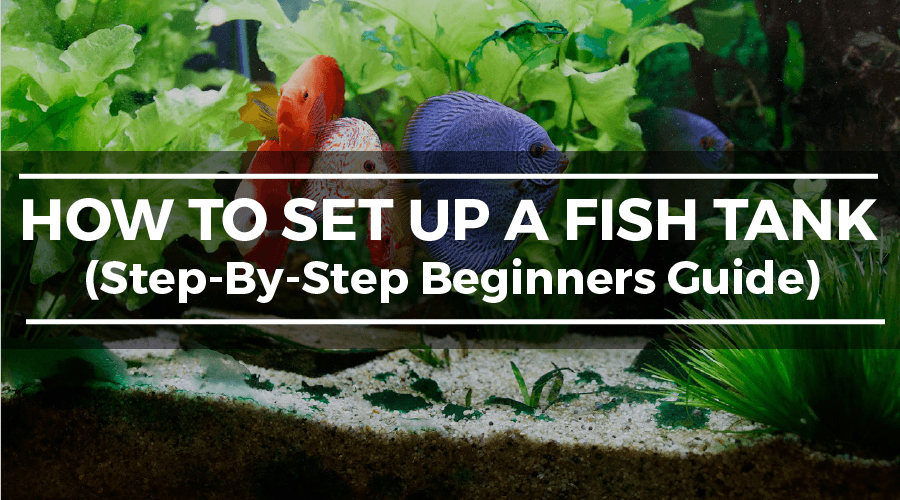
Setting up your fish tank correctly the first time can save you a ton of time and money in the long run. Here is our step-by-step beginners guide for how to start a freshwater fish aquarium:
Step 1: Gathering the Equipment
Picking out the right equipment is vital to the success of your tank. Remember, fish should not be kept in bowls. If you’re interested in buying a complete kit, we recommend the Marina 20 Gallon Kit. It contains most of what you need to get a tank running and is much better than other kits on the market.
If you’re looking for a more custom setup, here are a few things you will need:
- Tank: A lot of beginners make the mistake of thinking small tanks are easier. In reality, the tiny water volume of small tanks makes it very hard to control water parameters. In my opinion, 20 gallons is the magic number for first time fish keepers – large enough to offer some stability, but small enough so it’s not a ton of work.
- Filtration: Unless you’re keeping really difficult fish (which none of the above are), a hang-on-back filter should be more than sufficient. I’ve used the AquaClear Power Filter for years – it’s powerful and pretty quiet compared to other filters on the market.
- Heater: A heater not only gives you precise control over the water temperature of your tank, but also allows you to create a stable environment for your fish. I recommend the Cobalt Aquatics NeoTherm.
- Substrate: Most species on our list are fine with a simple gravel substrate (the only exception is Cory Catfish, which requires a softer sand substrate).
- Water Conditioner: Water straight from the tap is not suitable for aquariums, as it contains chlorine and other harsh chemicals. Water condition removes these toxins and makes your tap water safe for fish.
Step 2: Setting up the Tank
Now that you have all the right equipment, it’s time to put everything together! Here are a few basic steps to follow when setting everything up:
- Rinse & Lay the Gravel: Gravel straight from the bag will create a cloudy mess that is very hard to fix. Rinse until the water runs clean, then lay gently in the bottom of your tank.
- Fill & De-Chlorinate: Pour water into your tank as gently as possible. Once filled, add the appropriate amount of water conditioner per the bottle’s instructions.
- Aquascaping: Add decorations, live/fake plants, air stones, or anything else you desire. Smooth out the substrate if it is unlevel from the tank being filled.
- Heaters, filtration, lighting: Add your new heater, filter, and any other equipment you purchased. The filter will need to be primed with aquarium water before plugging it in. Never let a heater or filter run dry as these devices are water cooled and will burn out if run for long.
Step 3: Cycling Your Aquarium
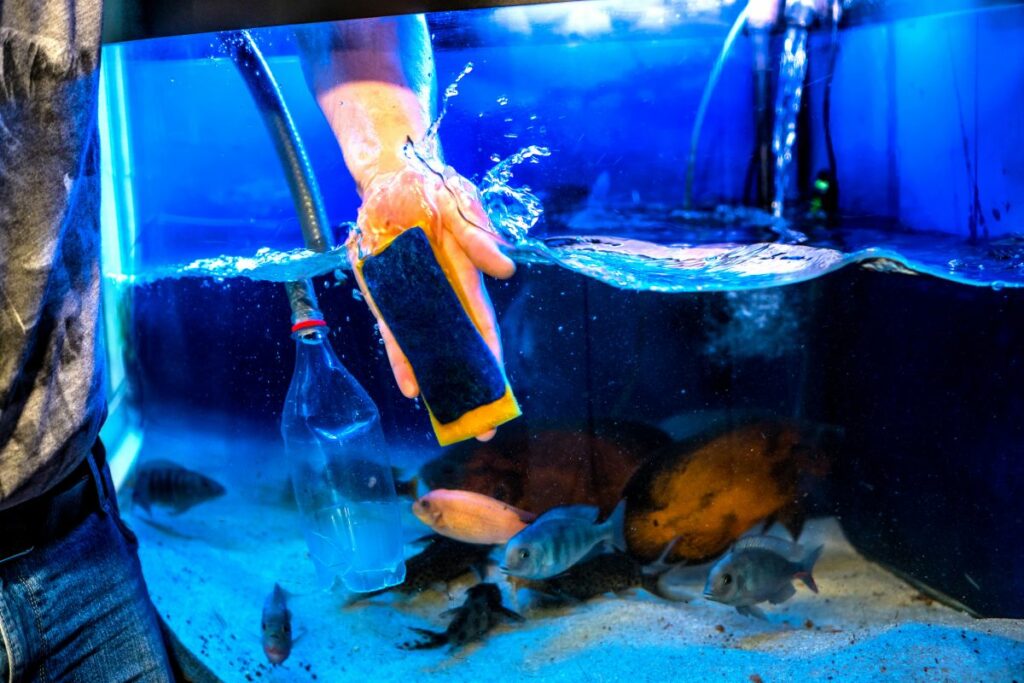
Cycling is the most important (although also the most ignored) step in setting up an aquarium. But what exactly is the cycling process?
The Nitrogen Cycle is the process of building up colonies of beneficial bacteria that convert harmful compounds (ammonia caused by fish waste and uneaten food) into safer compounds, such as nitrate.
Without these beneficial bacteria, Ammonia and Nitrite levels in your aquarium will skyrocket – which means serious problems for any tank inhabitants.
For the sake of making this article as short as possible, we’re not going to go through the entire process of completing the nitrogen cycle in this post. Instead, check out our beginner’s step by step guide to the nitrogen cycle here.
Step 4: Freshwater Aquarium Maintenance
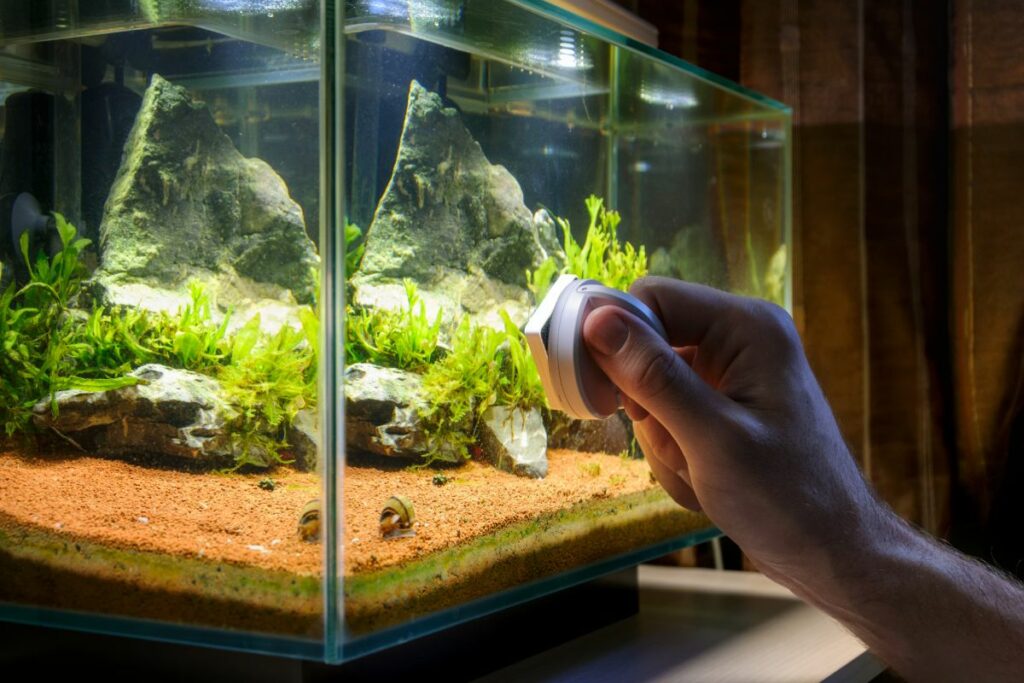
In order to keep your tank healthy, regular maintenance is required. Here are a few things you should do to keep your aquarium running smoothly:
- Weekly or bi-weekly water changes: Water changes are a great way to remove unwanted toxins (ammonia, nitrite, and nitrate) and re-introduce important trace elements that make for healthy fish. Make sure you always use water conditioner on the new water that you’re putting into your tank.
- Regular testing: Testing your water chemistry regularly is the only way you can really understand what’s going on beneath the surface. The API Freshwater Master Test Kit is the best water tester on the market.
- Filter cleanings: A lot of gunk tends to build up in the filter. Even so, never wash your filter under sink water. Huge colonies of beneficial bacteria (which are vital to the health of your tank) that live in the filtration media will be wiped out by untreated water. Rinse your filter sponge in a small cup of tank water for best results.
Step 5: Monitoring Aquarium Water Chemistry
Now that your aquarium is up and running you will need to keep a continual eye on the water quality. If the chemistry shifts too far in a particular direction you can end up with sick or dead fish.
What is healthy for one kind of fish might be toxic to another, especially where pH, water hardness, and salinity are concerned. So let’s take a closer look at how to monitor water quality for freshwater aquarium fish.
How to Lower Nitrates in Freshwater Aquarium
Once an aquarium is fully biologically cycled (see above), ammonia and nitrites should stop accumulating. Nitrate is the end result of the cycling process., however While aquarium fish do tolerate moderate levels of nitrate eventually this compound can become toxic to fish.
What nitrate concentration is deadly depends mostly on the fish in question. Betta fish and goldfish are more tolerant of nitrate. They won’t show ill effects unless the concentrations are greater than 30 parts per million (ppm). Meanwhile discus and many saltwater fish are sensitive to levels as low as 10 ppm.
The main way that nitrate leaves the system is through water changes. Old aquarium water is removed and fresh water added in. Live aquarium plants are another way since they use nitrate (as well as ammonia and nitrite) as fertilizer for their growth.
You should be doing both. While nitrates aren’t as poisonous as the other nitrogenous waste compounds they still don’t do fish any good. They also contribute to algae growth so we want to keep nitrates as low in concentration as possible.
How to Lower pH in Freshwater Aquarium
Another major parameter to track when caring for your freshwater aquarium is the pH. pH is a measure of the hydrogen ion concentration in a solution; i.e. how “acidic” or “alkaline” it is.
So what pH should a freshwater aquarium be? That depends on what kind of fish you have. Tap water in developed countries is hard (high GH/KH) and alkaline (high pH). For fish like livebearers and African cichlids these conditions are just right for them.
But what about fish that prefer a low pH like angelfish or tetras? These fish will sometimes survive in alkaline water but their appetites, colors, disease resistance, and willingness to breed are all affected. In the case of these low pH lovers we want conditions below a pH of 7.0 (neutral). Many of these fish even come from blackwater environments where the pH can be as low as 4.5.
The best way to lower the pH is to start off with water that is close to neutral. Then you can use small amounts of additives to bring down the pH. That means using reverse osmosis or distilled water for water changes.
How to Lower GH in Freshwater Aquarium
Using mineral-free R.O. and distilled water also has the added benefit of ensuring that minerals can’t build up in the water since acid-loving fish often prefer soft water as well. Hardness can be described and measured using both the GH (general hardness) and KH (carbonate hardness) scales.
Lowering general hardness means reducing the levels of calcium and magnesium in your aquarium water. And the two best methods of doing so both involve prevention, i.e. keeping minerals from getting in, in the first place.
Water softening pillows are capable of absorbing calcium and magnesium and are widely available. Though they have the downside of replacing these ions with sodium, increasing the overall salt content of your water.
Preventing evaporation – and topping off our aquarium with mineral-free water when it does happen – also keeps mineral levels low. Remember that tap water and minerals containing rocks or gravel are the main sources of GH. And the only way to avoid calcium and magnesium is to not add it via tap water or minerals.
How to Raise KH in Freshwater Aquarium
Sometimes we actually want a bit of mineralization, especially in the case of KH (carbonate hardness). kH is a measure of how stable your pH will be because carbonate acts as a buffer to swings brought about by acidifying agents like plant tannins or carbon dioxide.
So how to raise alkalinity in freshwater aquariums? The easiest way is to add a bit of carbonate in the form of baking soda. One teaspoon per 13 gallons will raise the KH by 4 degrees.
In most aquariums you will have both a high GK and high KH. This is because both minerals are found together naturally in rocks and other sources of minerals.
But if you keep freshwater dwarf shrimp and other animals that need non-standard water conditions then you may need to mix your own GH and KH blends to meet their needs.
I go into greater detail on how to understand water chemistry in my article here on how to raise ph in freshwater aquariums.
How Often to Add Salt to Freshwater Aquariums
Let’s take a moment to talk about aquarium salt in freshwater fish tanks. Because aquarium salt is something I recommend keeping on hand at all times.
Aquarium salt is a tonic that helps fish regulate the flow of ions across their skin and gill membranes. It stimulates healthy slime coat production and is an excellent anti-parasitic and antibacterial remedy for diseases like cotton wool disease.
But we need to be careful with using aquarium salt because freshwater fish do not need very much (except for mollies, which need some aquarium salt – even full saltwater).
How Much Salt Should I Put in My Freshwater Aquarium?
As a general tonic, one tablespoon per 5 gallons is enough for most aquarium fish. Be sure to look up the requirements of your specific fish. Tetras and other soft water fish are so sensitive that I don’t recommend using aquarium salt at all with them unless you are treating a specific disease. In which case, a salt dip can help.
But only add salt to aquarium water when performing a water change; don’t add it to water that’s being used to top off a fish tank. Salt, like other minerals, does not leave a fish tank when water evaporates.
It simply becomes more concentrated over time. It is only removed during water changes so you can also add it whenever you top off the tank with fresh water post-change.
What Kind of Salt for Freshwater Aquariums?
Make sure to use specifically aquarium salt; the iodine and anti-caking agents in table salt are not at all helpful to freshwater aquarium fish. If you want you can use marine aquarium salt formulas. But it is a lot more expensive, comes in huge amounts, and does not offer any real benefits to freshwater fish.
What Should My Freshwater Aquarium Levels Be?
I aim to keep my aquarium topped off right near the top of the glass tank. I don’t let much more than an inch of water ever evaporate from an aquarium.
Why? Because as water evaporates the minerals and chemicals it contains remain behind. This causes the concentration of chemicals to rise, which affects your fish.
Since water chemistry swings aren’t healthy for fish it is best to keep your tank topped off with mineral-free water so the chemistry remains stable over time.
Step 6: Dealing with Algae
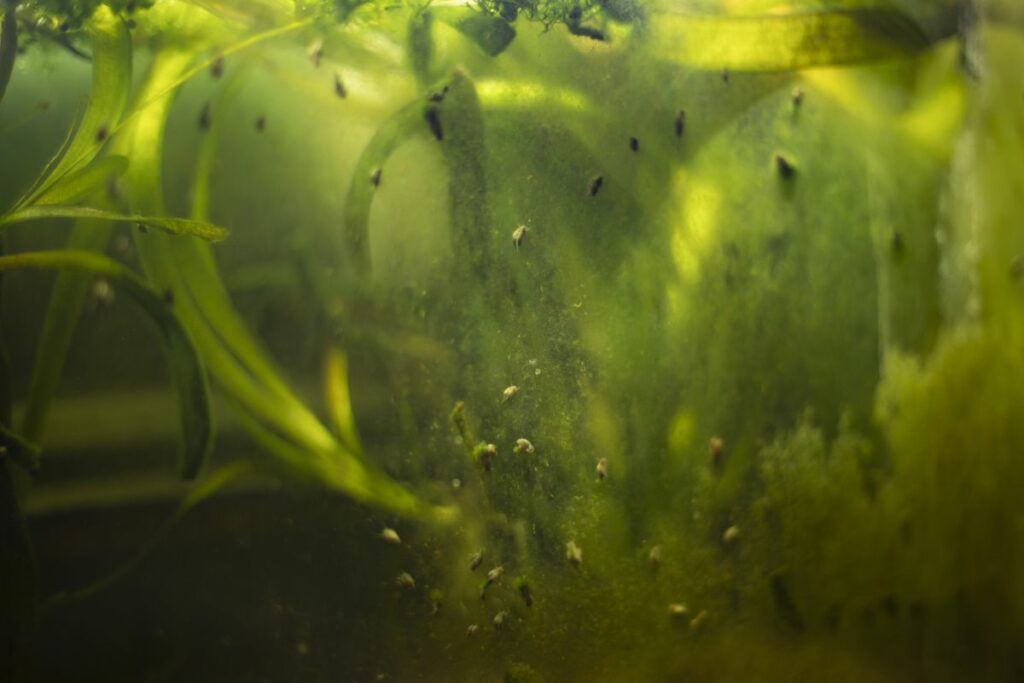
Even if you have the fish species chosen, aquarium setup and cycled, and your water chemistry fully figured out, there will always be algae to consider. Algae is a fact of life for all aquarium setups. So how do we deal with algae in all of its many forms?
Is Green Algae Good in a Freshwater Aquarium?
Green algae is never a bad thing; algae of any kind is a sign of life. Algae provides food for algae eaters like plecostomus and mollies. And grazing areas for baby fish and snails. It is when algae gets out of control that it should be thought of as a problem that needs to be eliminated.
While it can be scraped away from your aquarium glass to avoid being a detriment to your viewing experience we don’t want to eliminate all algae from your freshwater aquarium. Though if you want some help, you should consider my article here on what is the best algae eater in freshwater aquariums.
What Causes Green Algae in Freshwater Aquariums?
If you are seeing too much green algae growth then there is an imbalance somewhere. Almost always the problem is being caused by too much light, nutrients, or both. Nutrients can come from fish poop, leftover food, or a rich substrate.
And too much light might be lights that are left on for too long, are very high intensity, or of a spectrum that your live plants don’t make optimal use of. All of these matter because if you have live plants then they need the right kind and amount of light to suck up the nutrients that algae would normally use. If your light is poor quality then your plants can’t compete very well with algae, which is much hardier and flexible than complex plant life.
What Causes Red Algae in Freshwater Aquariums?
Red algae is a little different and unfortunately, more problematic. Some red algae is quite beautiful, especially red saltwater macroalgae. But in freshwater aquariums we usually have to deal with black beard and staghorn algae.
Both of these types are ignored by most algae eating fish because they are bitter or even poisonous. Red algae is usually caused by improper amounts of carbon dioxide, lights, and nutrients. They are a sign that your aquarium plants aren’t getting the nutrients they need and can’t compete with the red algae growth.
More Frequently Asked Questions about How to Start a Planted Freshwater Aquarium
Sometimes when setting up a new fish tank people want to talk about plants as well. Since freshwater aquarium plants aren’t for everybody I left them out of the main guide. But what if you want something a little more advanced to start?
A planted freshwater aquarium is actually an extremely involved project that is very different from a fish only tank. It involves understanding what sort of lights plants need as well as carbon dioxide and other nutrient flows that fish only aquarium systems don’t require. That’s why I go into the fine details right here in my guide on how to start a planted freshwater aquarium.
In order to plant freshwater aquarium plants, you need to be careful with the roots. Plant them gently to avoid crushing them; bruised roots can rot, which usually results in death. And once you have fully planted them avoid the temptation to move them around every so often. Plants hate being moved and it causes them a lot of stress, which can also lead to weakening, melting, and death.
Final Thoughts
Keeping freshwater aquarium fish can be an extremely rewarding and enjoyable hobby – but it definitely comes with a good amount of work. Though this complete guide, you should be able to choose a great beginner fish and set up your tank the correct way.
Good luck and happy fish-keeping!


Thanks.
I have a Convict Cichlid. He is the lone survivor. As you say, he does tend to kill his neighbors.
I’ve had him or her about 5 years or more. I may try another Cichlid to keep him company.
Maybe not.
Thanks for the great article. It was fun to read. I learned a lot!
Hi Terry, thanks for the kind words! Convict Cichlids have a special place in my heart since it was the first species I ever kept. The albino varieties are very interesting as well!
Unfortunately, I never had much luck keeping them with other fish – my large male didn’t take too kindly to anything I tried to keep with him (even females). As you said though, many people have had success keeping other large cichlid species.
Good luck!
Jason